So, you want to jazz up your yard but don’t feel like ripping everything out? Focusing on your fence line is honestly a pretty clever move.
That fence isn’t just there to keep the dog in—it’s a blank slate begging for a little style, some texture, and maybe a bit of life.
Whether you’re after a simple look or something that shouts “Look at me!”, you’ll find plenty of ideas here to fit your taste and energy level.
You might not expect it, but even a tiny change along the fence can totally shift your backyard’s whole vibe.
Try tossing in some plants or switching up the layout—suddenly, your fence looks like something you actually want to see every day.

It’s all about making your outdoor spot feel more “you.”
1. Plant climbing roses for a romantic, fragrant fence line.
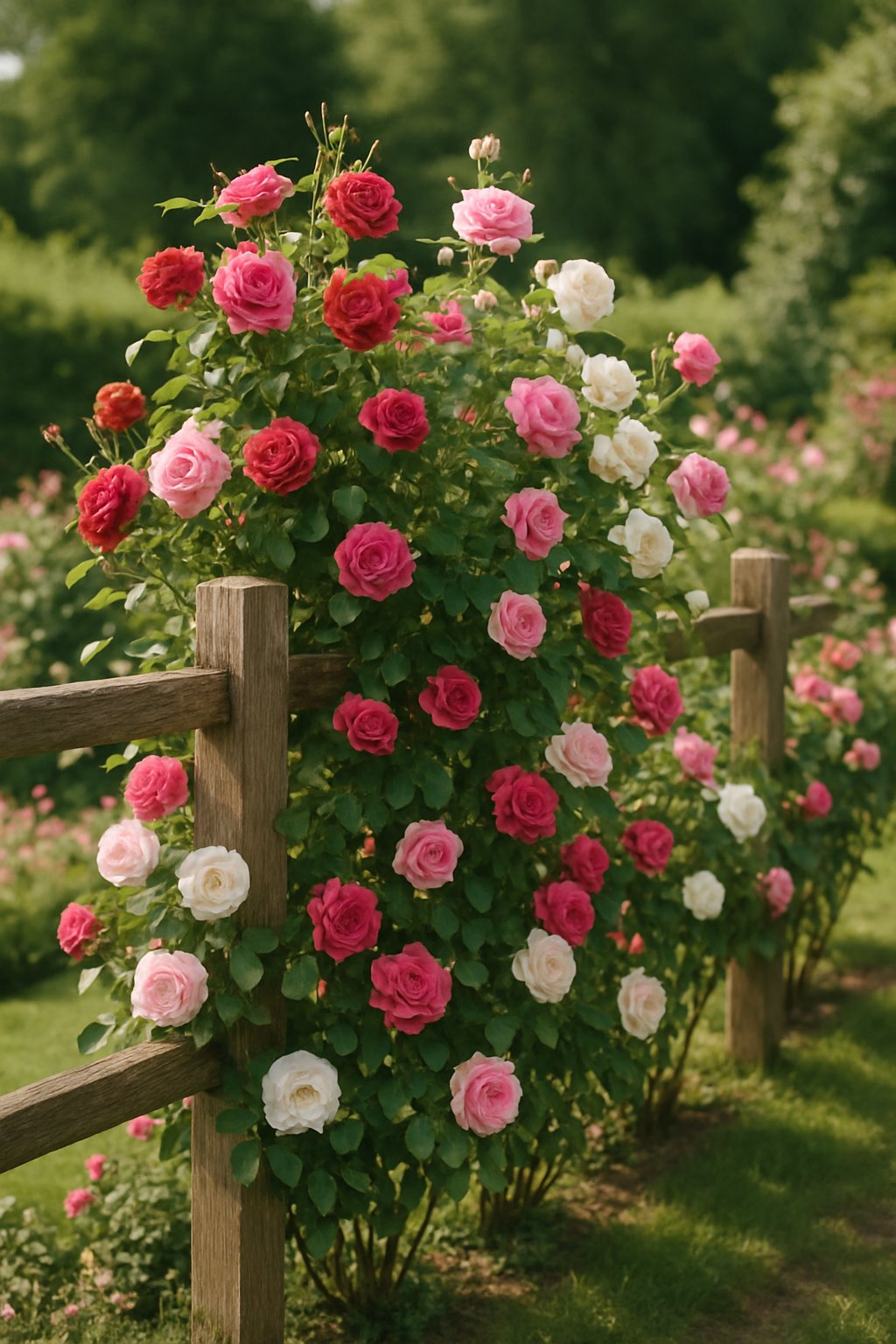
Climbing roses seem like they’d just take off on their own, right? Nope.
You’ll need to give them a little nudge—tie those stems gently to a fence or trellis, and they’ll reward you with a wall of color and sweet, old-fashioned perfume that makes your yard feel extra cozy.
There are loads of types to pick from. You can go wild with colors or stick to one shade for a classic look.
They’ll need a bit of watering and some snipping here and there, but honestly, it’s worth it. When you treat them right, they’ll keep blooming for months.
If you want a pretty privacy screen, climbing roses do double duty. Imagine those soft petals blocking out nosy glances and making your fence look like it belongs in a fairy tale.
Expert Tip From MrPlanter: “Give your climbing roses plenty of sun and water them well to keep them happy. Don’t forget to prune regularly to help more flowers grow.”
2. Use bamboo for a fast-growing, privacy-enhancing hedge
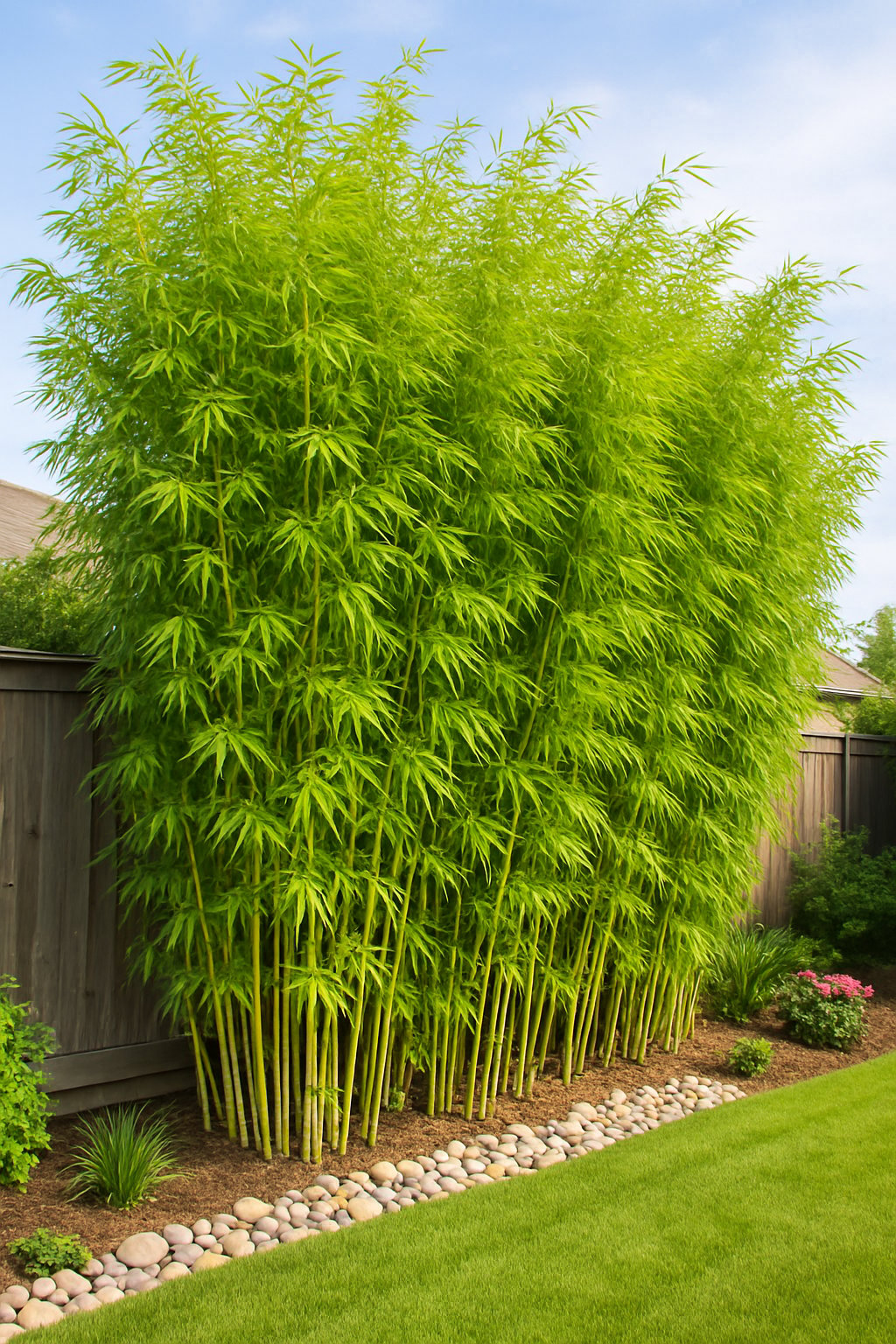
Bamboo might just be the speed demon of the plant world. Some types shoot up four feet in a single day—no kidding.
If you’re in a rush for privacy, bamboo steps in fast. It grows thick and tall, turning your fence into a green wall that keeps out prying eyes and street noise.
Bamboo doesn’t fuss much. It shrugs off most pests and handles weird weather like a champ.
Plus, it gives your fence line that calm, zen look. Just a heads-up: some bamboo spreads like it’s in a race, so pick clumping varieties if you want to avoid a backyard jungle.
Expert Tip From MrPlanter: “Pick clumping bamboo to keep your hedge neat and friendly. Water it well the first year, and soon you’ll have a green wall that grows fast and stays beautiful.”
3. Create a living wall with vertical planter pockets
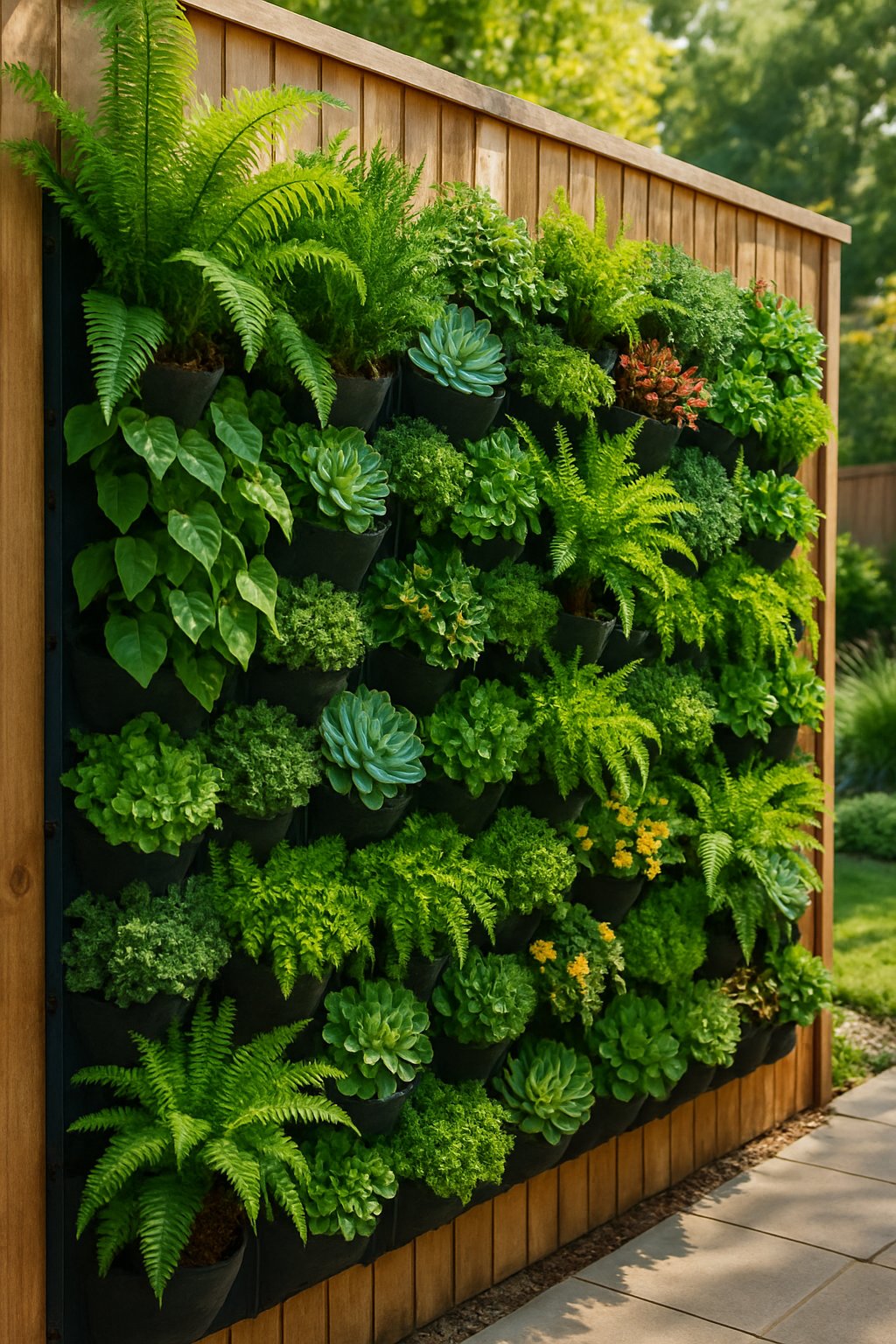
Your fence doesn’t have to be just a boring divider. With vertical planter pockets, you can turn it into a living wall that’s basically art you water.
These pockets are like little apartments for your plants—flowers, herbs, even some veggies if you’re feeling ambitious.
Vertical planters save precious ground space and add a splash of green to small yards. Just hang them up, fill with dirt, and pop in your favorite plants.
Keeping them watered is easy, especially if you use self-watering pockets. Suddenly, your fence is doing more than just standing there.
Expert Tip From MrPlanter: “Start with hardy plants like succulents or herbs—they’re easy to care for. Water your pockets regularly, but don’t drown your plants; they like just the right amount!”
4. Add lavender bushes to attract pollinators and smell amazing.
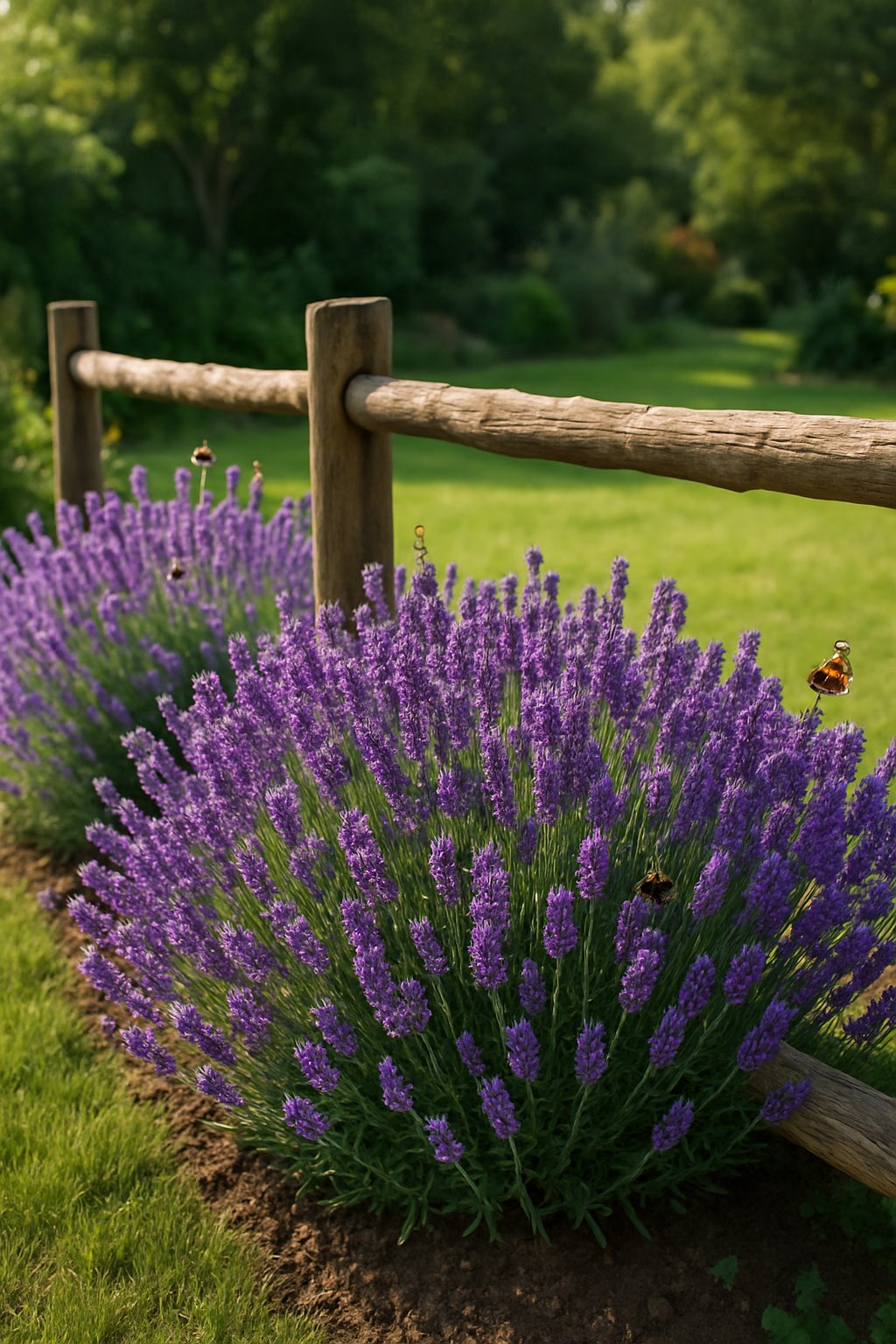
Lavender is basically a party invitation for bees and butterflies. Pop a few bushes along your fence, and suddenly your yard is buzzing with happy pollinators.
That’s not just good for your flowers—it’s great for your veggies too.
Lavender’s purple blooms look lovely and fill the air with a scent that’s both calming and fresh. Plus, it’s pretty chill about water once it settles in.
You can mix lavender with other shade-friendly plants or just let it shine solo for a neat, classic look. Either way, you get color, scent, and a little wildlife show right by your fence.
Expert Tip From MrPlanter: “Plant lavender in well-drained soil and give it plenty of sunlight. A little trimming after flowering keeps it looking tidy and encourages new blooms.”
5. Line the fence with ornamental grasses for texture and movement.
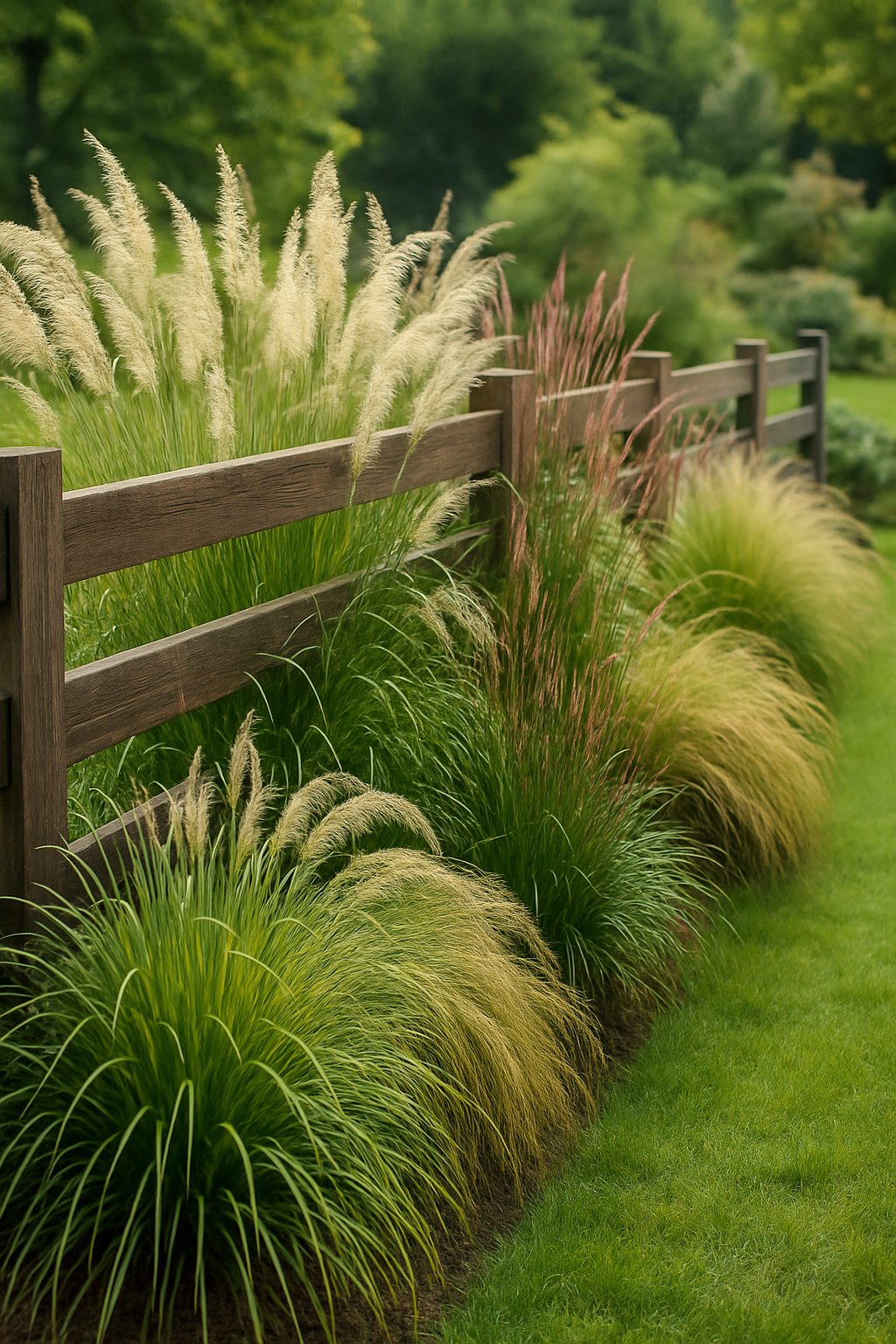
Grasses might sound boring, but trust me—they bring your fence line to life. When the wind blows, these grasses sway and ripple, almost like your yard is breathing.
Ornamental grasses come in all sorts of heights and colors. You can mix and match until your fence looks like a living painting.
They break up the hard lines of a fence and make your garden feel softer. Plus, they barely need any care once they’re settled in.
If your fence is light-colored, go for tall, dark grasses for a cool contrast. Your yard will look fresh and stylish without any real effort.
Expert Tip From MrPlanter: “Pick grasses that grow well in your sun and soil conditions to keep care easy. Trim them back once a year to keep their shape tidy and let new growth pop!”
6. Mix colorful perennials like coneflowers and black-eyed Susans.
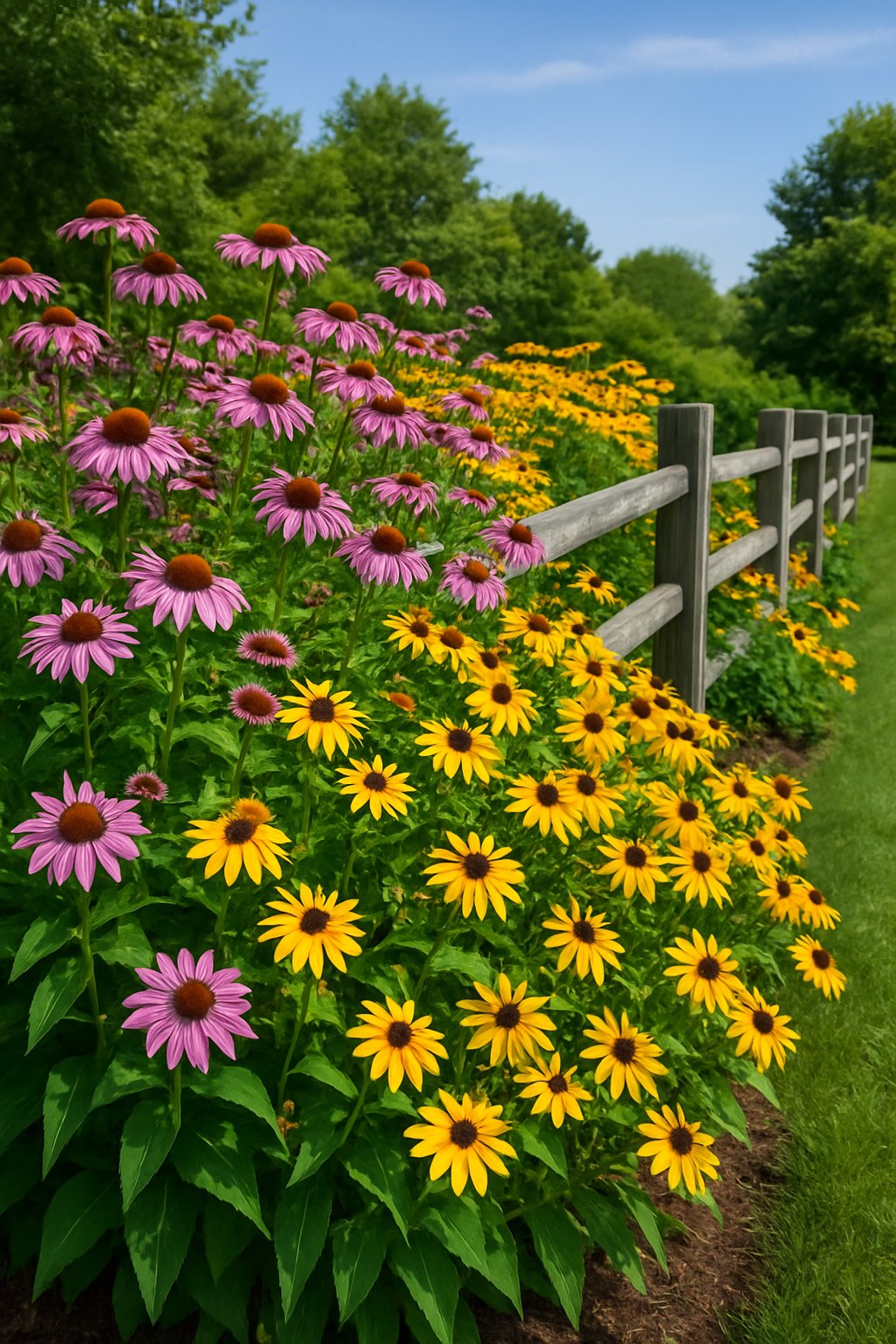
Choosing flowers for your fence line doesn’t have to be a puzzle. Coneflowers and black-eyed Susans make a dream team.
They bloom in bold purples and yellows that really stand out against green leaves. Your fence line will look cheerful all summer.
Both plants love soaking up the sun and don’t mind if you forget to water now and then. They also attract bees and butterflies, bringing even more life to your garden.
Plant them together for a natural, laid-back look. Their different shapes and colors play off each other and keep things interesting. And since they’re perennials, they’ll come back year after year.
Expert Tip From MrPlanter: “Choose spots where these flowers get plenty of sun and space. They grow better when they’re not crowded, helping them stay healthy and strong.”
7. Install raised garden beds along the fence for veggies or flowers
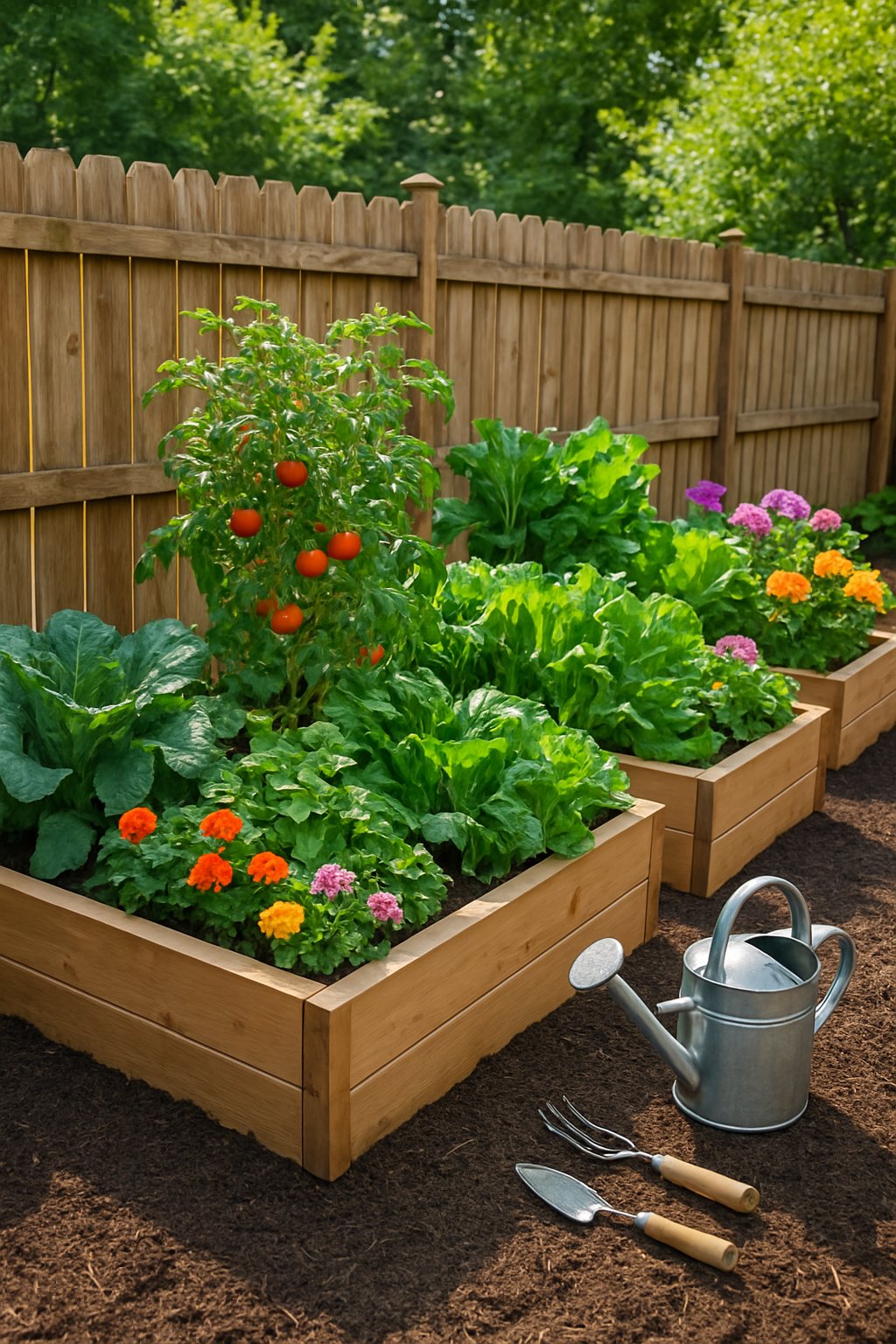
A fence doesn’t just mark your space—it’s actually a great helper if you want to grow more plants. Raised beds along the fence let your veggies and flowers thrive without hogging all your yard.
These beds lift your plants up off the ground. That means better drainage, fewer weeds, and less bending for you. Your back will thank you.
You can pick wood, stone, or metal to match your style. Try adding climbing plants on the fence for a burst of color and extra life.
Expert Tip From MrPlanter: Start small with one or two beds so you don’t get overwhelmed. Water your raised beds regularly, but don’t drown your plants—just keep the soil moist enough to make them smile.
8. Plant thorny shrubs like hawthorn for natural security.
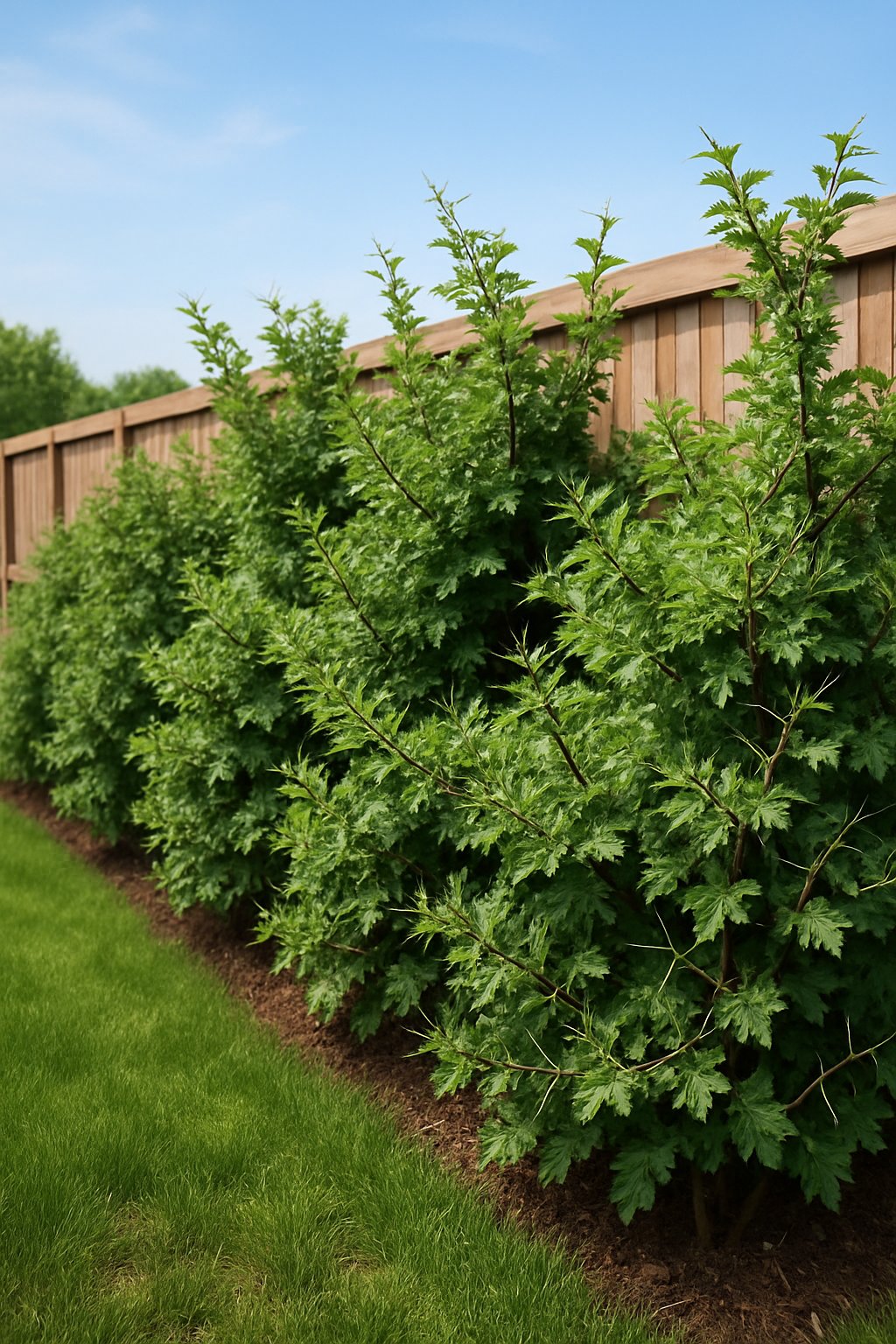
Who needs a security system when you’ve got thorny shrubs? Hawthorn bushes come armed with sharp thorns that make sneaking through your fence line pretty much impossible.
These shrubs grow thick and lush, giving you privacy and protection. And they don’t just look tough—those green leaves and little flowers actually add some charm.
Plant them close together for a solid, living barrier. You’ll get all the security with none of the clunky hardware.
Expert Tip From MrPlanter: Plant hawthorn in sunny spots for the best growth. Water regularly at first to help the roots settle in.
9. Use native wildflowers for low-maintenance, eco-friendly beauty.
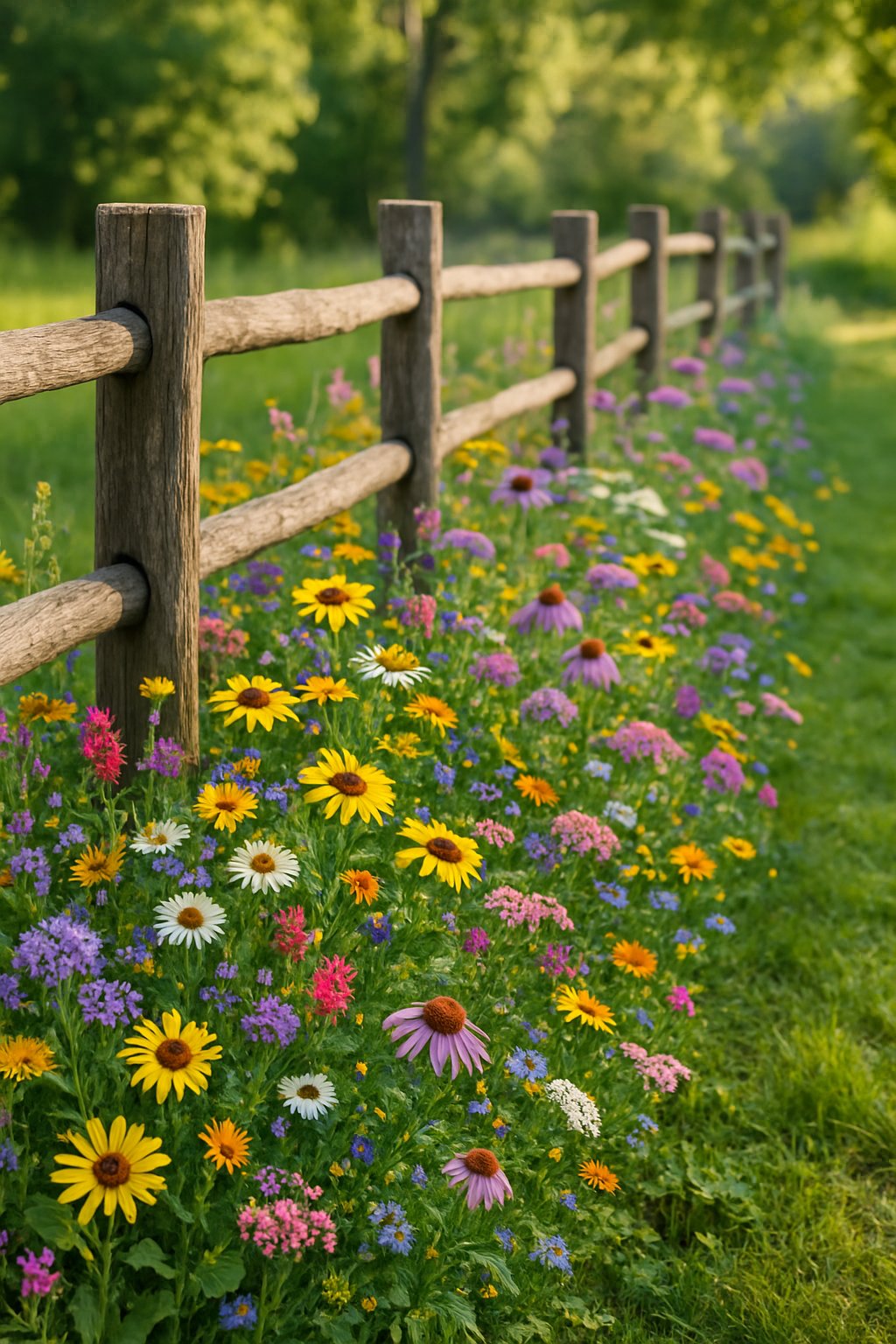
Wildflowers aren’t just for open fields—they look fantastic along a fence line too. Native varieties barely need any pampering once they get going.
You spend less time working and more time admiring the view.
Wildflowers bring color and buzz all season long. Bees, butterflies, and even birds will drop by for a visit.
Since these plants fit right in with your local weather, they’re tough and bounce back from rough patches. Your fence line will look natural, colorful, and full of life.
Expert Tip From MrPlanter: Plant a mix of wildflowers that bloom at different times. This keeps your fence colorful from spring through fall!
10. Decorate with hanging flower baskets to save ground space
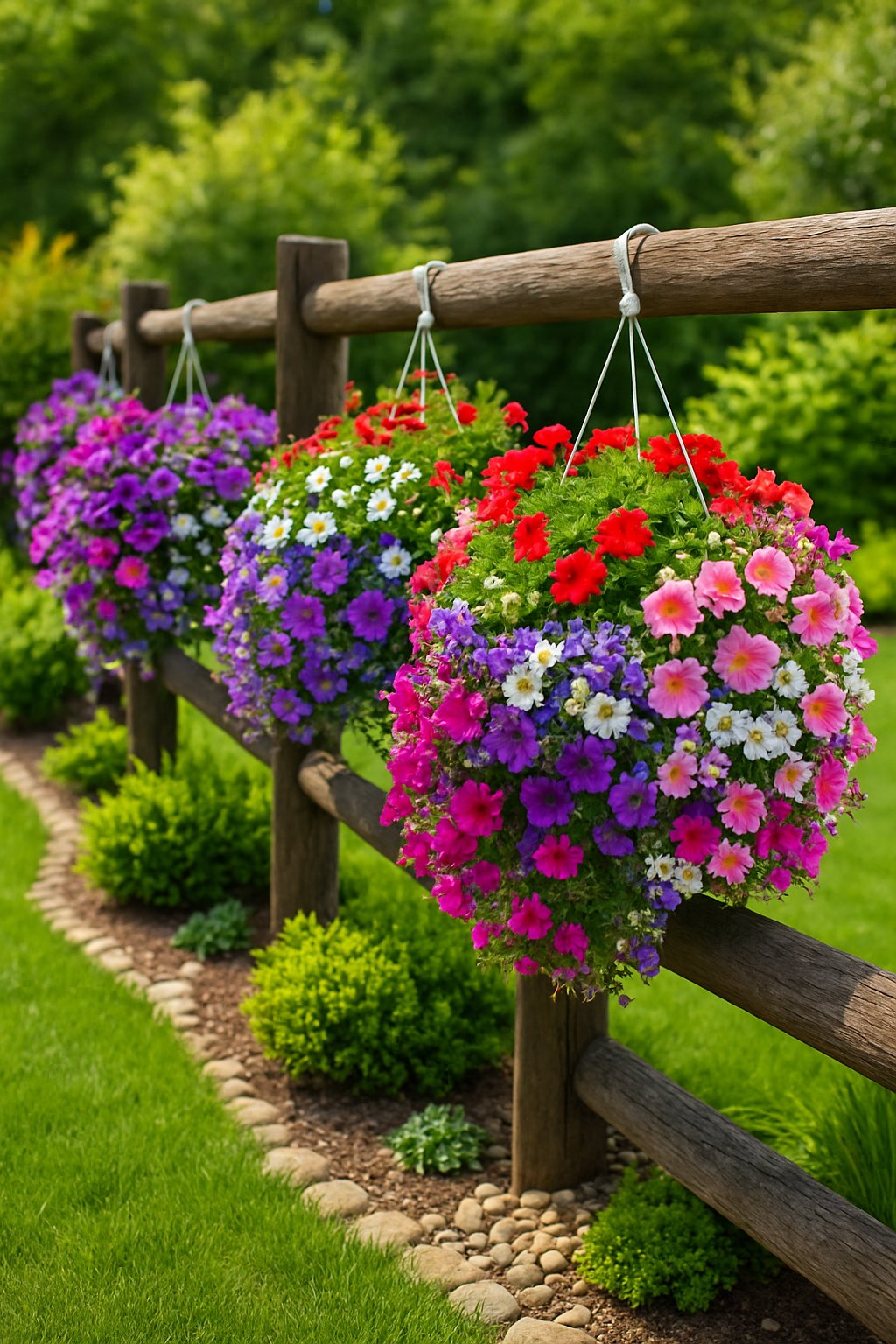
Think you need a big yard for lots of flowers? Hanging baskets say otherwise.
They let you pile on the color without eating up precious ground space.
Hang baskets on hooks, fences, or even tree branches. Your fence line looks cheerful and busy, even if you’re short on space.
Flowers at eye level are easier to enjoy and smell. Plus, they stay out of reach from curious pets or sneaky bugs.
Try mixing trailing plants like petunias with some leafy greens for a fuller look. You can even sneak in a few herbs for bonus points.
Expert Tip From MrPlanter: Choose lightweight pots and secure hooks well to keep your baskets safe. Water regularly since hanging baskets dry out faster than ground plants.
11. Place fairy lights or lanterns intertwined with vines for nighttime charm.
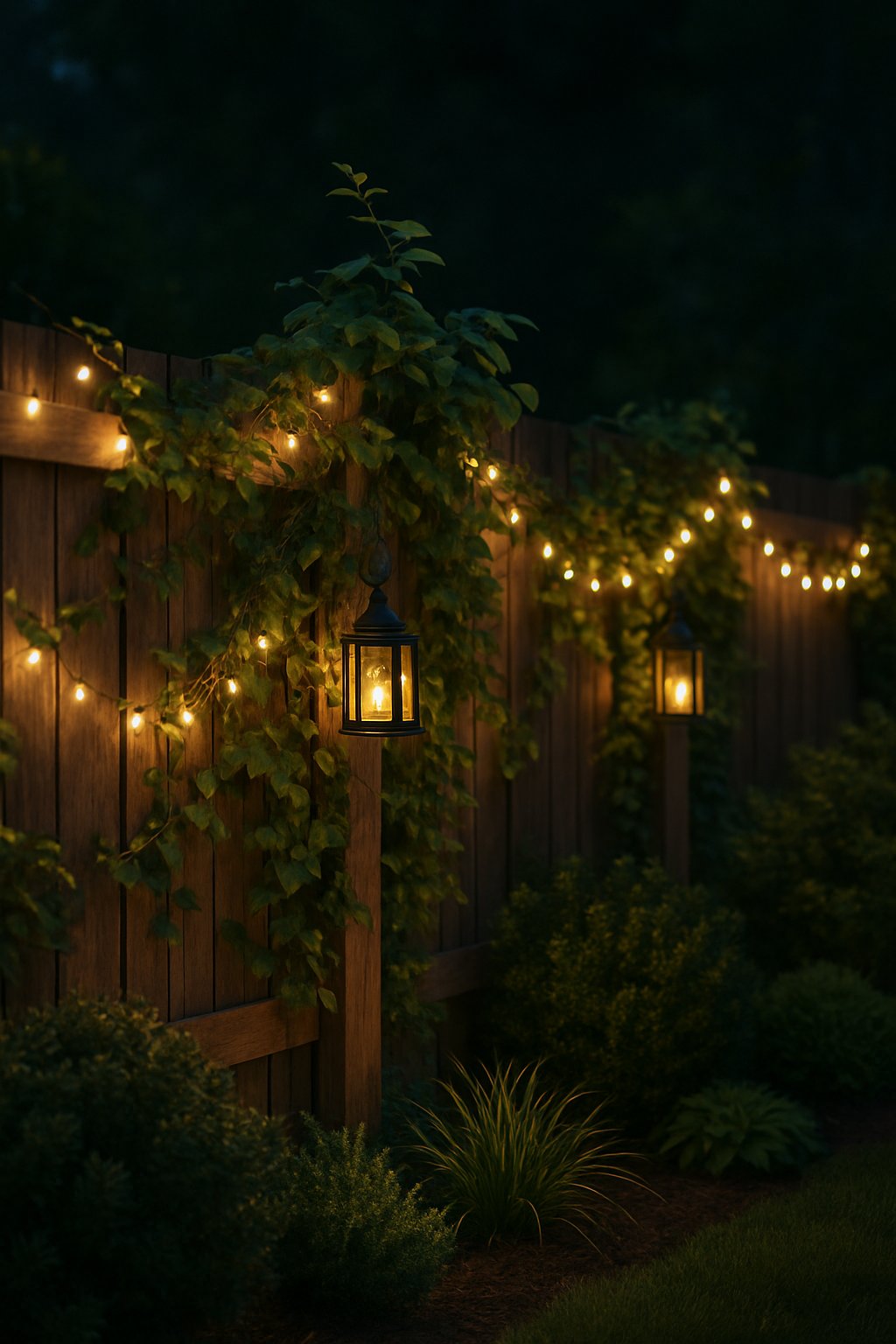
Fairy lights aren’t just for December—they can make your fence feel magical all year. Weave them through your vines, and suddenly your backyard glows with a cozy, welcoming vibe.
The lights make leaves and flowers pop, turning your fence into a nighttime showstopper. Add a few lanterns for extra charm, and you’ll want to spend every evening outside.
Setting it up is easy. Just wrap the lights gently around your plants and let them do their thing.
Expert Tip From MrPlanter: Choose solar-powered fairy lights to save energy and avoid messy cords. Plant some fragrant vines nearby to make your magical fence smell as good as it looks.
12. Grow clematis for vibrant, vertical pops of color.
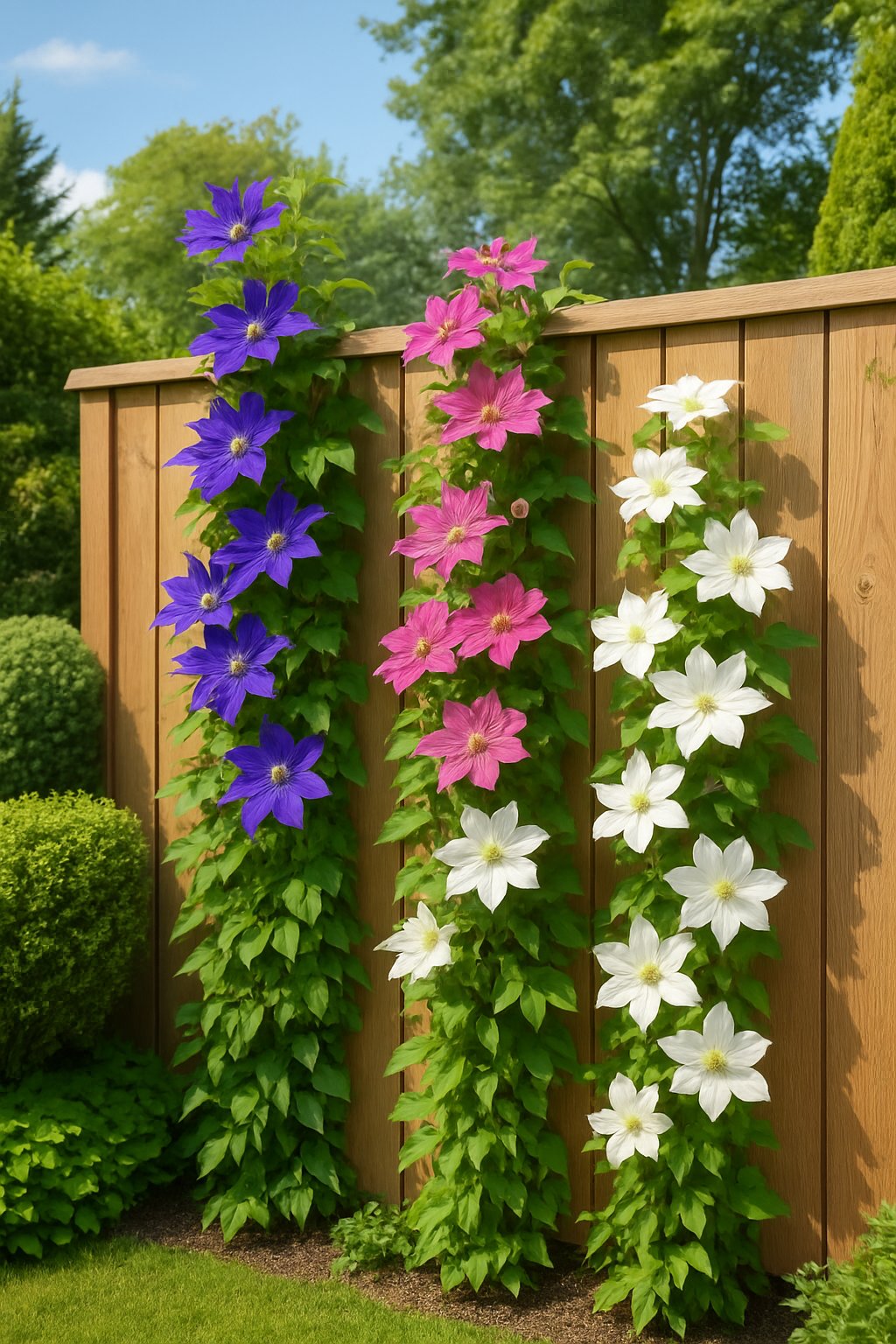
Fences aren’t just for keeping nosy neighbors out—they can totally help your garden shine. Clematis vines love to climb and will turn a boring fence into a wild, flowery masterpiece.
These plants show off huge, bright blooms every year. You don’t need to baby them much, just make sure they get some sunshine and a drink now and then.
Training clematis? Honestly, it’s simpler than teaching a dog to sit. Just guide the vines up posts, trellises, or even some string. Suddenly, your fence pops with color that keeps changing through the seasons.
Expert Tip From MrPlanter: Start with a sturdy trellis or thick fishing line. Keep the roots cool and shaded, but let those leaves soak up the sun for the best flower show.
13. Create a cottage garden vibe with hollyhocks and foxgloves
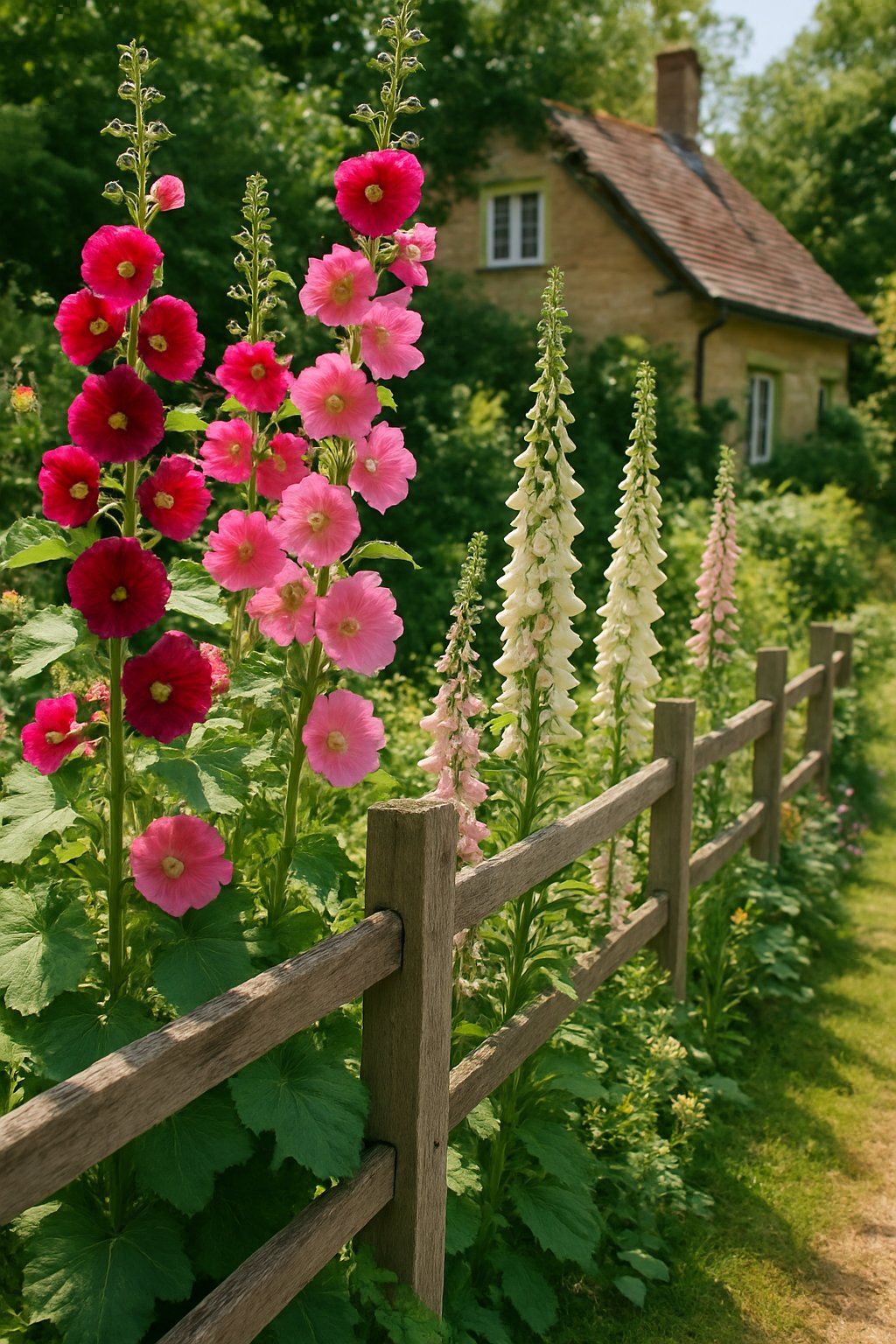
Think a fence line can’t feel cozy? Toss in some hollyhocks and foxgloves and watch the magic happen. These tall, classic flowers bring a soft, storybook vibe with hardly any work.
Hollyhocks add old-school charm and serious height. Foxgloves join in with their delicate, bell-shaped blooms. Together, they make your fence look like it belongs in a fairy tale, not just a backyard.
Plant them close to the fence, and you’ll get a thick, colorful wall that softens all those straight lines. No need for fancy gardening skills either—these guys are pretty chill.
Expert Tip From MrPlanter: Plant hollyhocks and foxgloves in groups for a full, natural look. Water them well when they’re young so they settle in and get comfy.
14. Plant hydrangeas for lush blooms and big impact
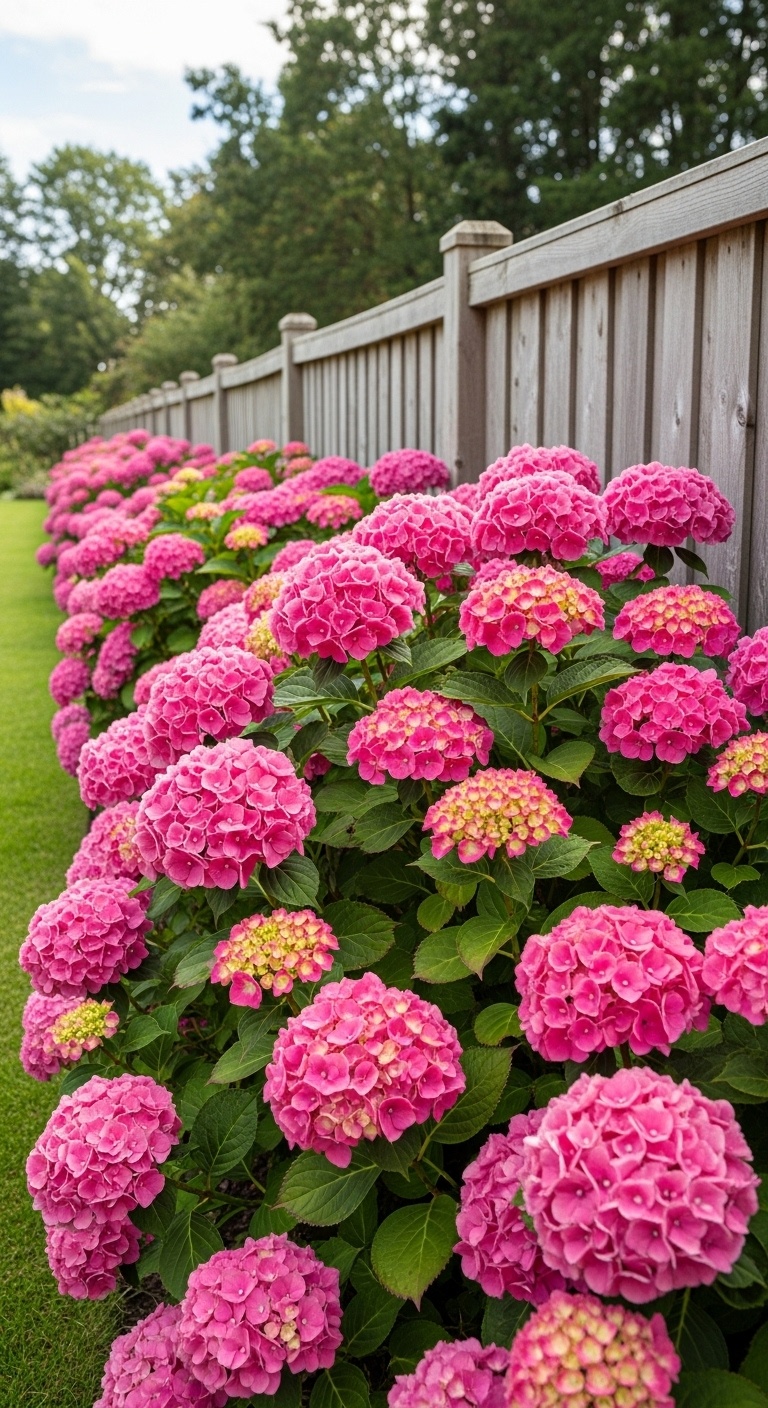
A fence line doesn’t have to be boring—just plant some hydrangeas and watch the place transform. These shrubs grow big and leafy, and their blooms last all summer.
Hydrangeas fit in almost anywhere, whether you’ve got lots of sun or a bit of shade. They bloom in giant clusters that light up your yard.
Pair them with hostas or ferns for extra texture. This combo turns your fence line into a lush, inviting spot, and you don’t have to fuss over it much.
Expert Tip From MrPlanter: Hydrangeas are thirsty, so keep the soil moist, especially when it’s hot and dry. Mulch helps keep them cool and happy all summer.
15. Install a trellis and train jasmine or honeysuckle to scent your space.
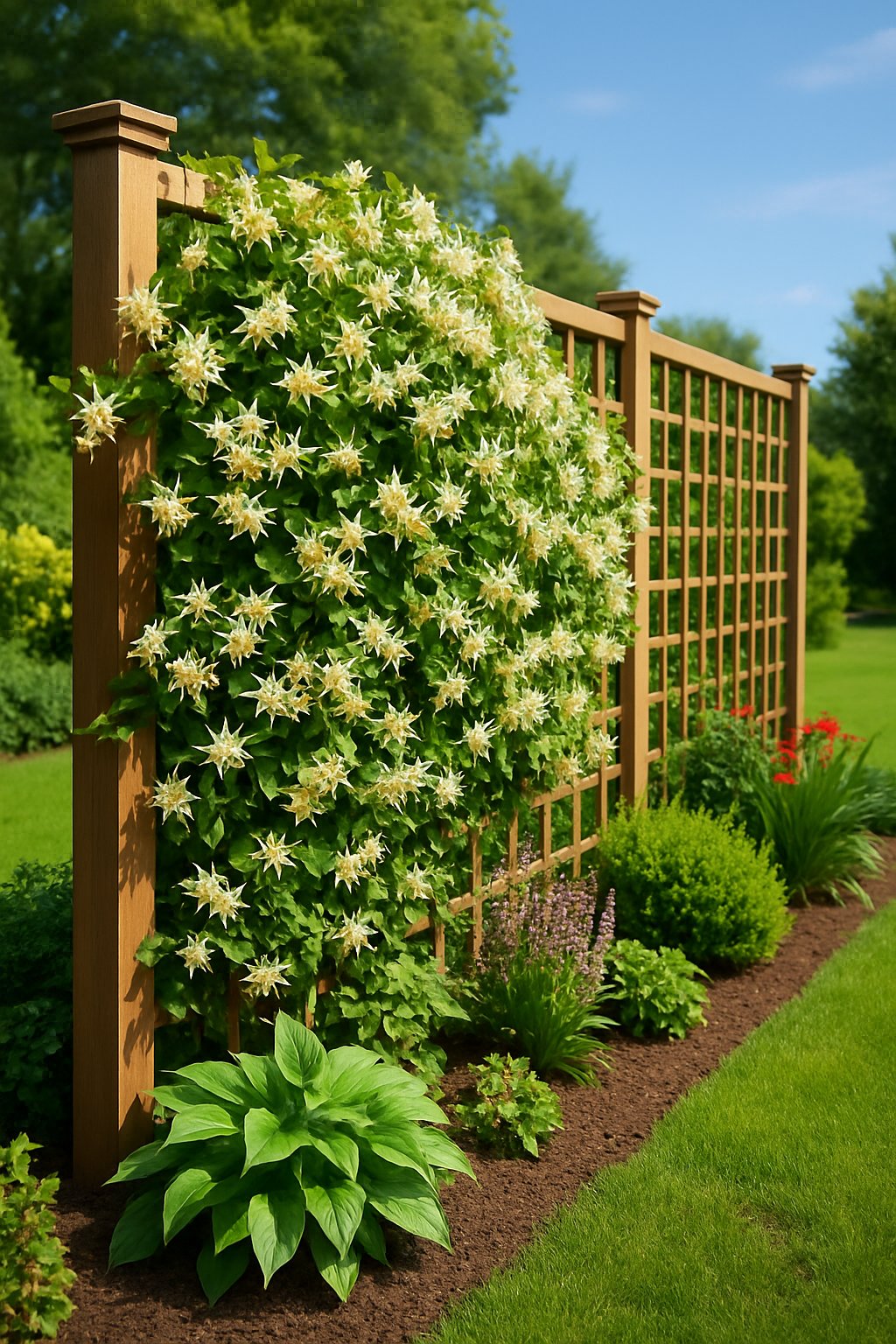
Some plants can turn your fence into a natural perfume shop—seriously! Add a trellis and train jasmine or honeysuckle, and your yard will smell amazing.
Just lean a sturdy trellis against your fence and gently guide the vines as they grow. Use soft ties to help them weave through. Give them a trim now and then to keep things tidy and blooming.
Jasmine and honeysuckle both love sunshine, but they’ll handle a little shade, too. They grow fast, so your fence will be covered with green leaves and sweet-smelling flowers before you know it.
Expert Tip From MrPlanter: Start with fresh, nutrient-rich soil. Water your vines regularly, but don’t overdo it—happy roots mean loads of blooms!
16. Use raised stone planters for a neat, modern look
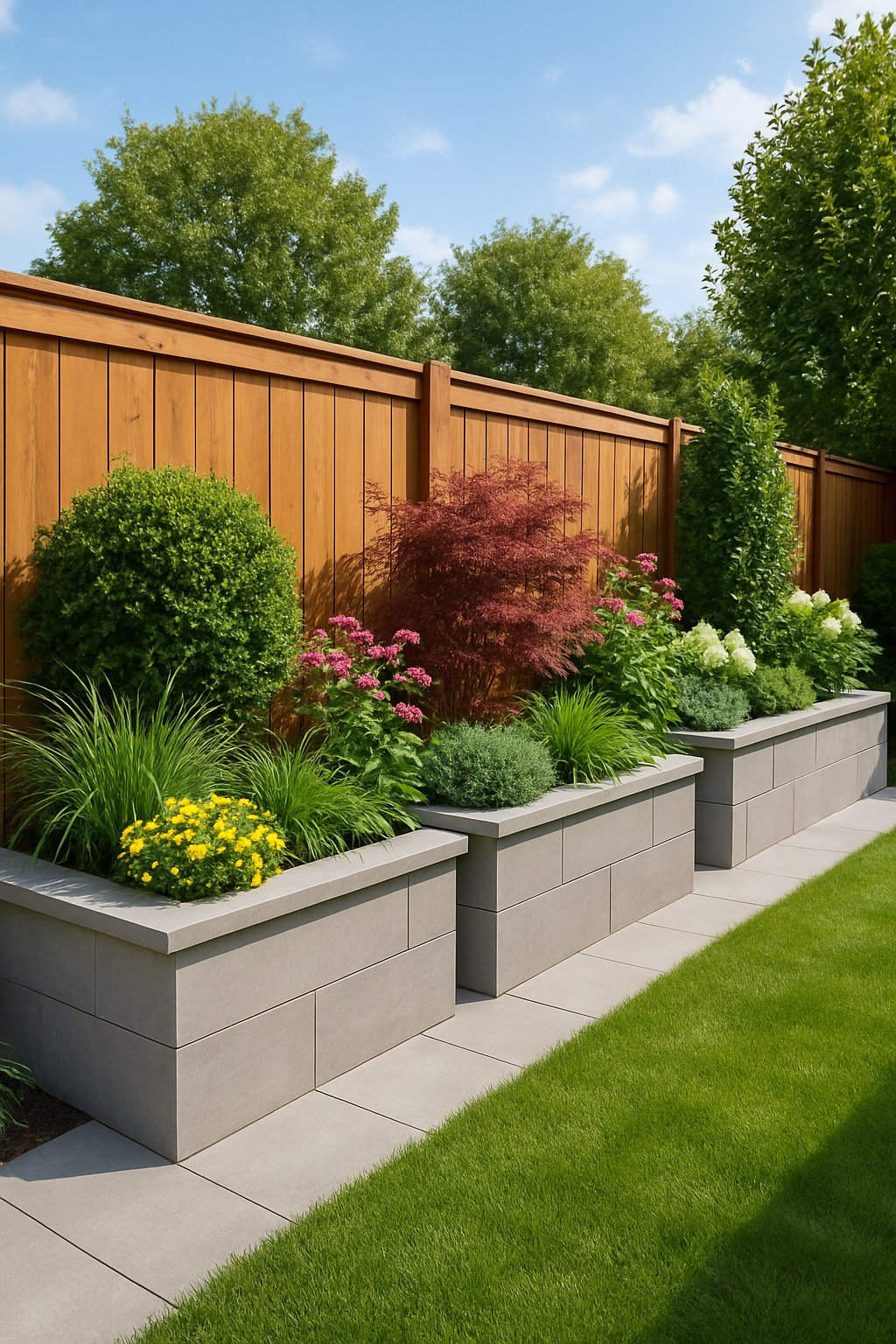
Stone planters aren’t just for fancy mansions—they’re awesome for a clean, modern style. Raised stone planters frame your fence line and keep things looking sharp.
Stone holds its shape, so your beds stay tidy all year. You can pack them with flowers, herbs, or even some veggies. Plus, raised beds make watering and planting easier on your back—no more crouching like a garden gnome.
Try stacking a few layers for some extra height and drama. Put tall plants in back, shorter ones in front, and suddenly your fence line has some real style.
Expert Tip From MrPlanter: “Pick stones that match your house for a smooth look. Line the base with landscape fabric so weeds stay out and your plants stay happy.”
17. Add edible plants like herbs or raspberries along the fence.
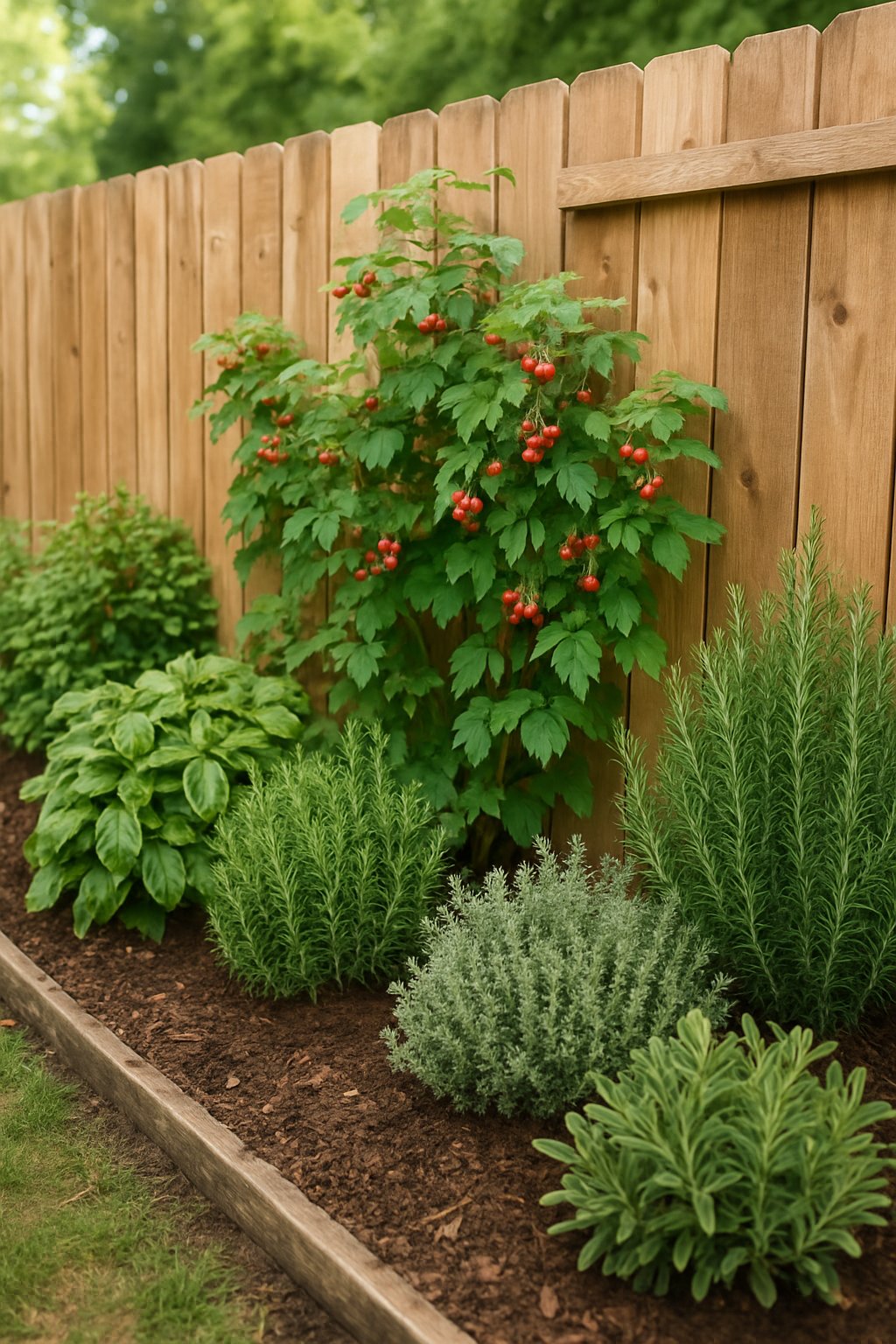
Why settle for a boring fence when you can snack right from your garden? Plant herbs or raspberries along the fence and you’ll have fresh treats within arm’s reach.
Herbs like thyme, parsley, or mint grow well next to fences. They don’t hog space and smell fantastic. Raspberries love to spread out, and a fence gives them the perfect spot to climb.
You can even mix in edible vines like passion fruit or blackberries on chain-link fences. It’s a tasty way to use up space and makes your yard feel extra lively.
Expert Tip From MrPlanter: “Start small and see what thrives in your yard. Water often, especially at first, so your edible fence takes off and keeps on giving.”
18. Place birdhouses or feeders to invite feathered friends
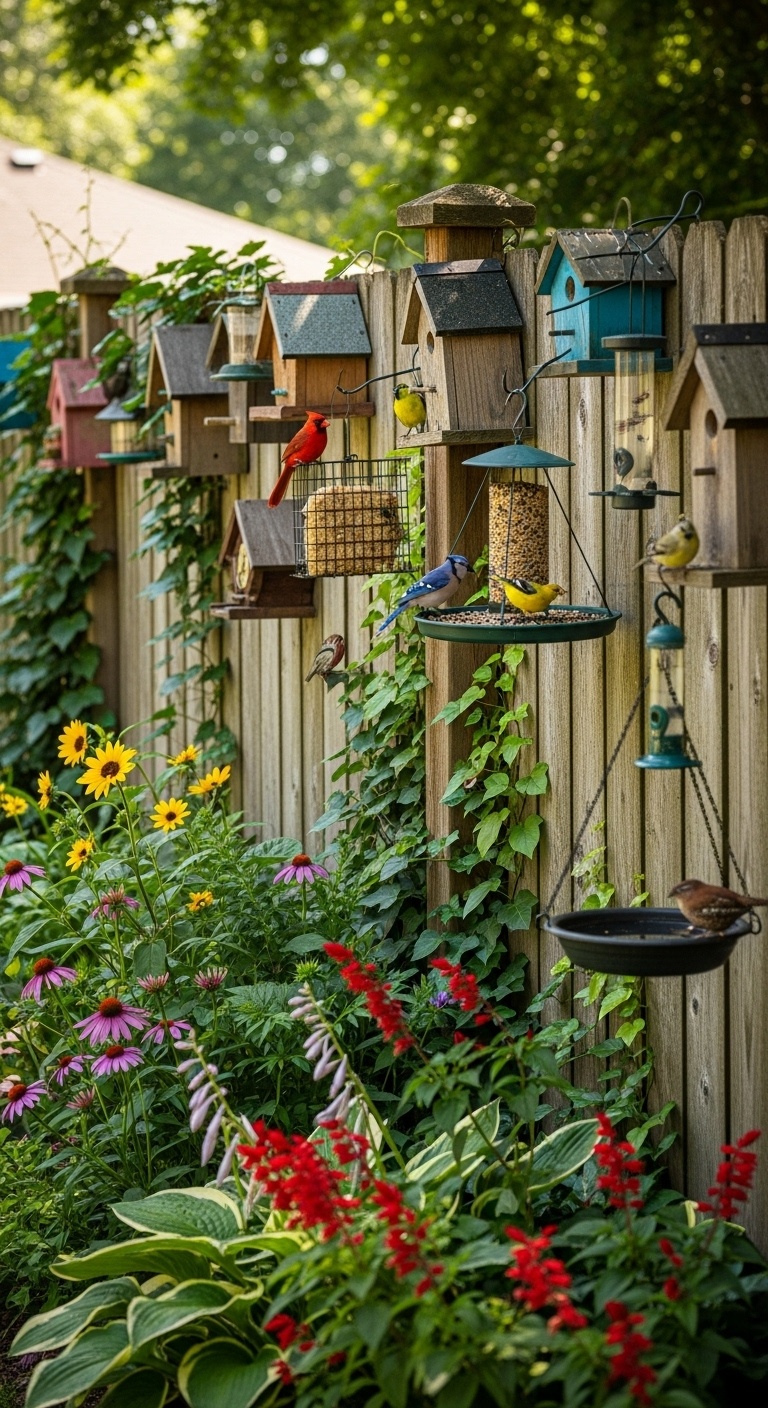
Birds can turn your fence line into a lively hangout spot. Add a few birdhouses or feeders, and suddenly your yard is full of chirping, colorful guests.
Hang birdhouses at a safe height where birds feel protected. Face them away from strong winds if you can. Put feeders near flowers or bushes to give birds food and shelter.
Simple feeders, like pine cones rolled in peanut butter and seeds, work surprisingly well. Match your birdhouses to the birds in your area—different birds like different homes. Before you know it, your fence is a bird paradise.
Expert Tip From MrPlanter: “Hang feeders where you can watch but not bother the birds. Keep feeders clean and water fresh to keep your feathered pals coming back.”
19. Combine shrubs and succulents for drought-resistant appeal
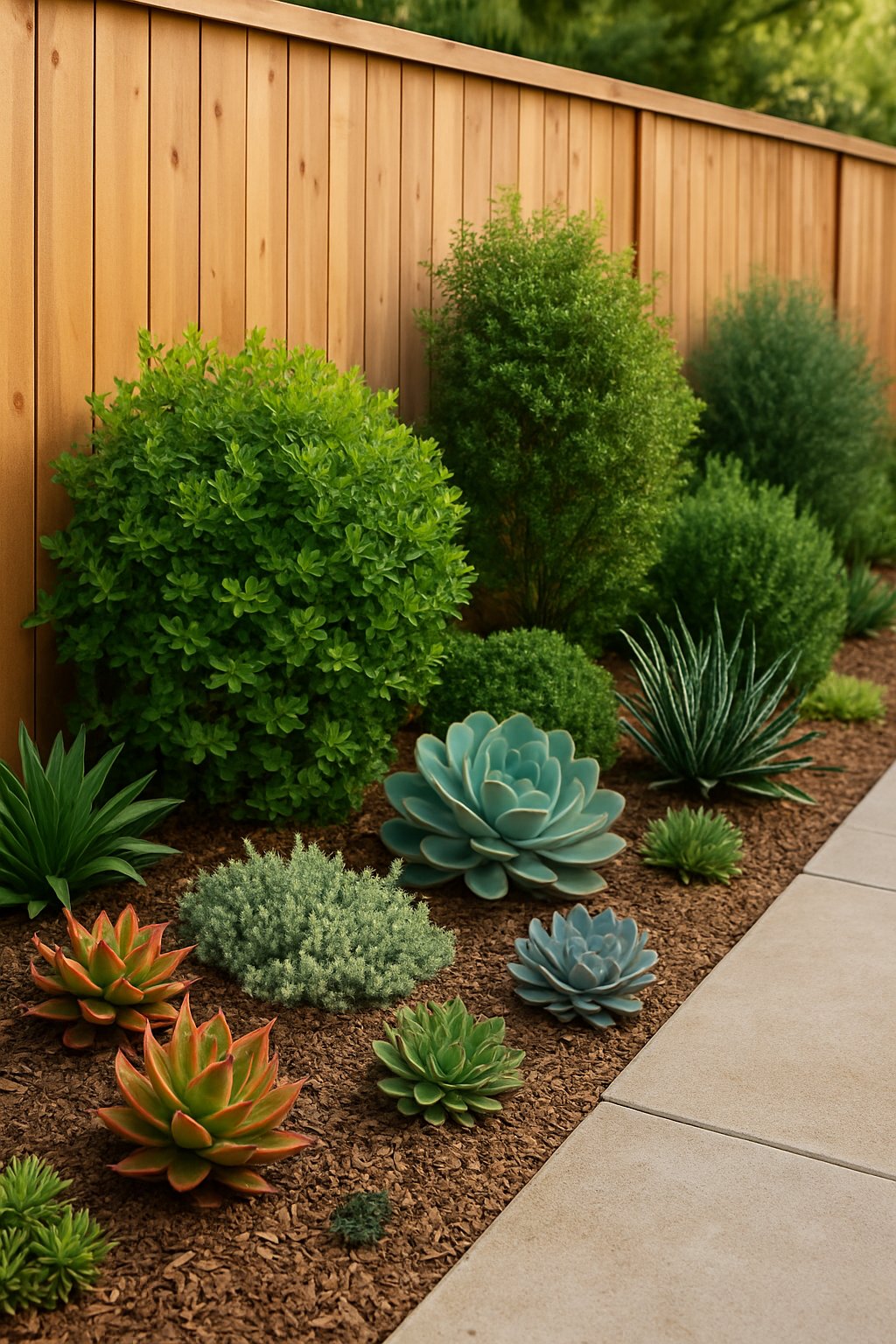
Shrubs and succulents might seem like an odd pair, but they actually work great together. Shrubs give your fence line some height and shape, while succulents offer cool textures and colors down below.
Try shrubs like rosemary or lavender—they handle dry spells and look good year-round. Succulents like echeveria or sedum come in all sorts of shapes, and they barely need any water.
Plant taller shrubs behind the succulents to shield them from harsh sun and wind. Gravel or mulch around the succulents helps hold moisture and keeps weeds out. It’s a low-hassle setup that saves you time and water.
Expert Tip From MrPlanter: “Pick plants that like the same amount of sun and water. That way, your garden stays happy with hardly any extra work.”
20. Use espalier fruit trees against the fence for a neat orchard feel
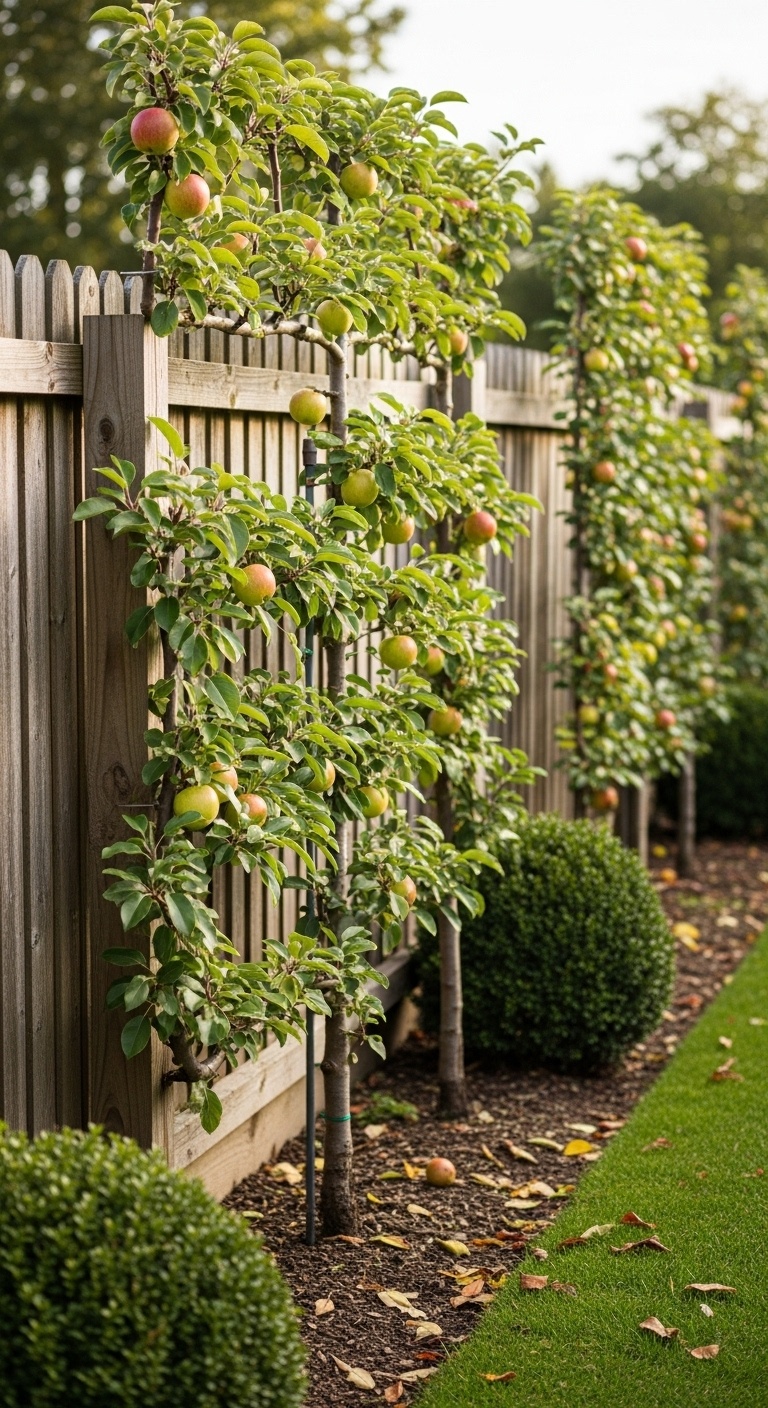
You can turn a plain fence into a fruit wall with espalier trees. These trees grow flat against the fence, making your yard look tidy and giving you fresh fruit.
Train the branches to grow sideways for a neat, easy-to-manage line. Apples work great, but you can try pears or other fruits too. You get privacy, charm, and snacks all in one spot.
Espalier is perfect for narrow spaces. It’s like having an orchard without losing your whole yard. Plus, picking fruit is a breeze when it’s right at your fingertips.
Expert Tip From MrPlanter: Start training your trees when they’re young for the best shape. Patience pays off—soon you’ll have a fence full of tasty fruit!
21. Incorporate ornamental grasses with flowering bulbs for seasonal contrast
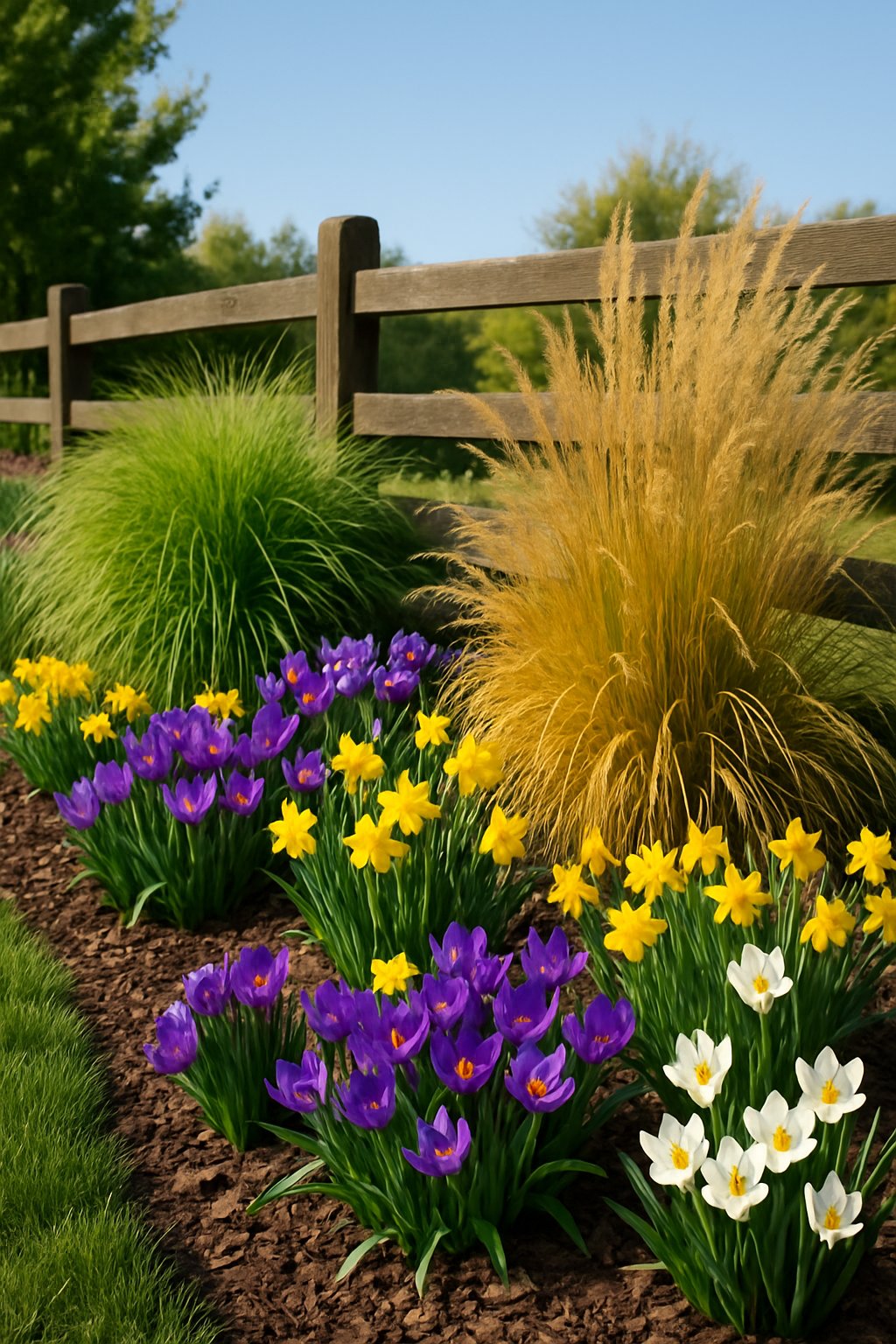
Ornamental grasses and flowering bulbs actually make a fantastic team. Grasses bring movement and softness, while bulbs pop up with bright colors at just the right moments.
Picture tulips or daffodils blooming in spring, peeking through swaying grasses. When the bulbs fade, the grasses keep things looking full and interesting.
This mix keeps your fence line lively and fresh. The grasses are super low-maintenance, and bulbs add bursts of color without any fuss.
Expert Tip From MrPlanter: Plant bulbs in clumps for a bold look, and let the grasses grow tall behind them. It’s an easy way to keep your fence line looking great all year.
22. Plant viburnum for fragrant flowers and colorful berries
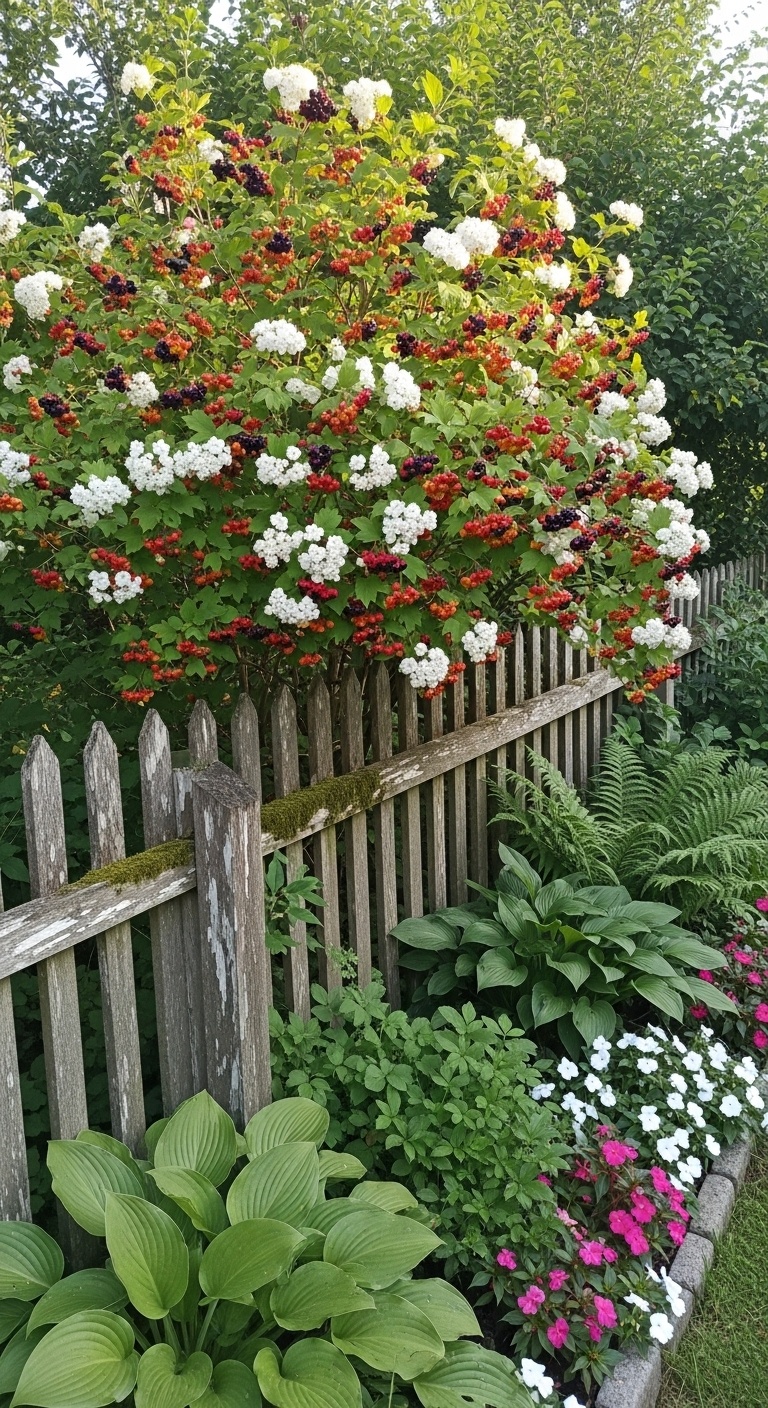
Viburnum plants are like the superstars of the garden—seriously, they do it all. In spring, they fill your fence line with sweet-smelling flowers. Later, they show off colorful berries that attract birds and add a splash of life.
These shrubs grow fast and work as a living fence or screen. You’ll love their fall leaves, too—they turn red or orange and keep things bright even when the weather cools down.
Stick viburnum along your fence for year-round interest with hardly any work. It’s like having a living decoration that changes with the seasons.
Expert Tip From MrPlanter: “Plant your viburnum in sun or part shade for the best blooms. Water it well during dry spells and enjoy your fragrant, colorful fence line buddy for years.”
23. Add bold, architectural plants like yucca or agave for a desert vibe
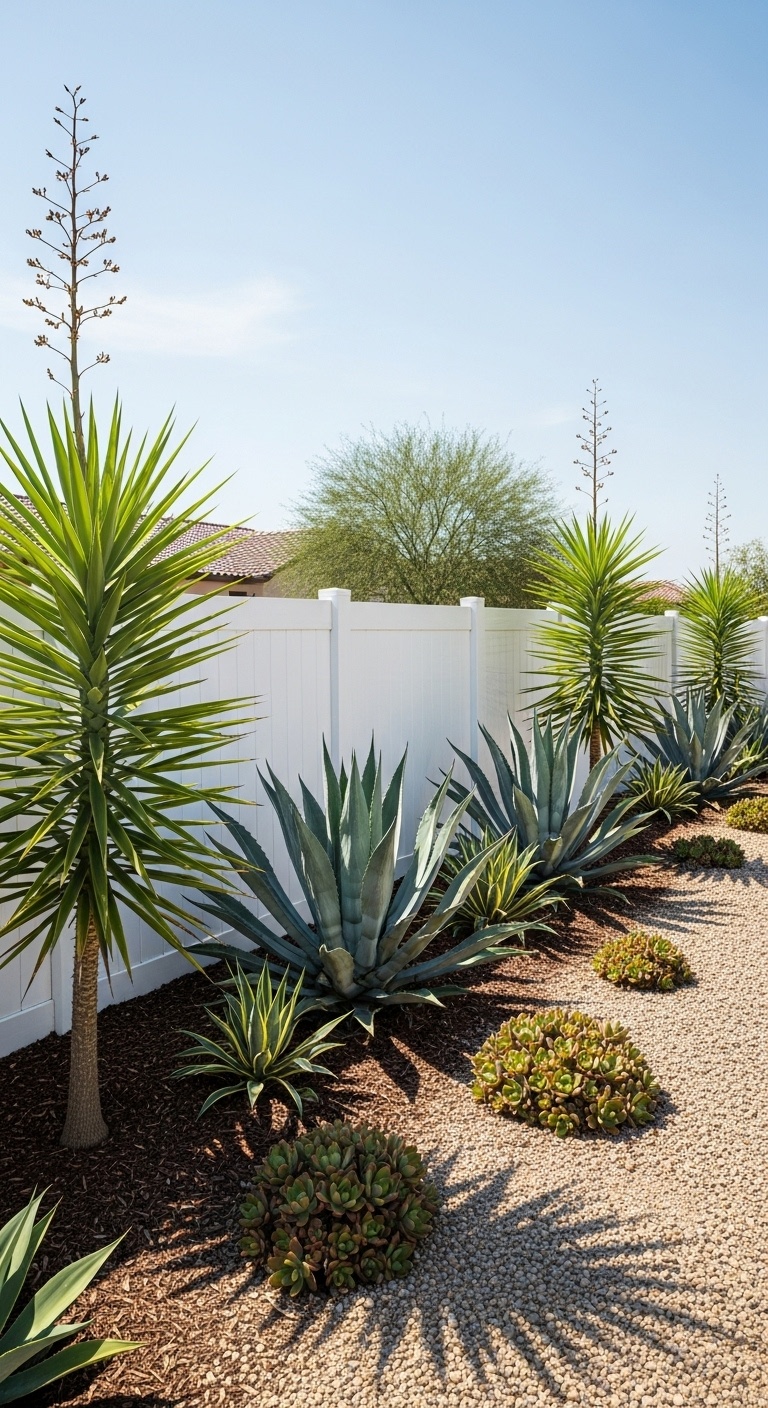
So, you might look at yucca and agave and think, “Aren’t these way too pokey for my fence line?” But honestly, these tough guys are surprisingly easy to handle and they make your yard look awesome.
Their strong shapes pop out without begging for water or endless attention.
Those spiky leaves? They totally bring a modern, almost futuristic vibe to your space.
They love dry spots and you won’t have to baby them.
Picture your fence line turning into a bold backdrop, thanks to these show-off plants.
I like to toss in some small rocks or gravel around them—it keeps things tidy and lets the plants shine.
Suddenly, your yard’s got personality, and you didn’t even have to clutter it up.
Expert Tip From MrPlanter: “Pick younger agave or yucca plants for easier shaping as they grow. Don’t crowd them—give these bold beauties room to shine.”
24. Use creeping ground covers like creeping thyme at the fence base.
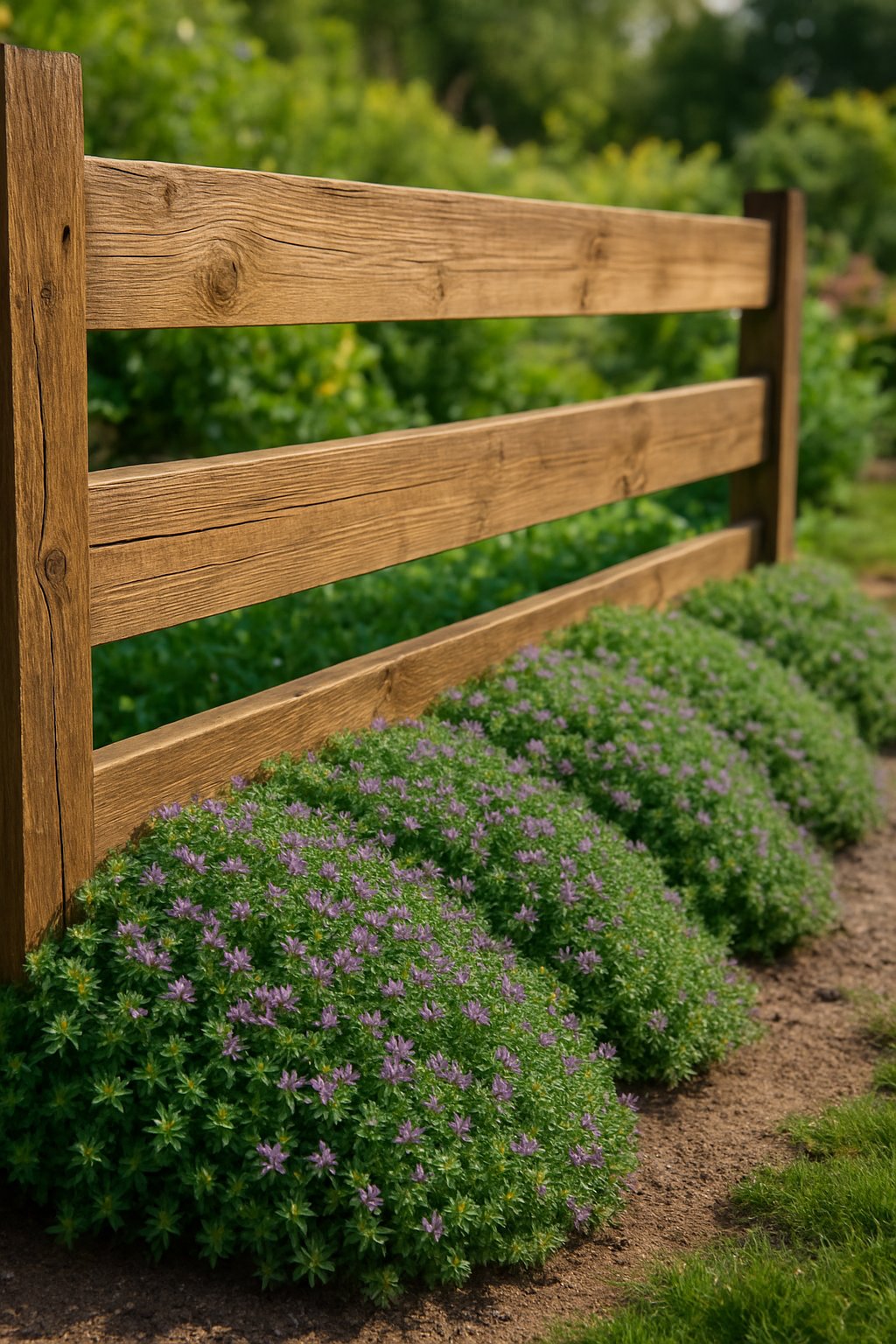
That empty spot at the bottom of your fence? It’s not wasted space—it’s a golden chance to make your garden look lush and save yourself some work.
Creeping thyme is a little legend.
It spreads fast, covers those bare patches, and brings in soft green leaves and tiny, cheerful flowers.
You’ll find weeds don’t stand a chance, so you can skip some of those boring weed-pulling sessions.
This plant loves a sunny hangout and shrugs off dry spells.
You’ll water less, and when you brush past it, your fence line smells amazing.
Try planting it between stepping stones or along pathways for a living, green carpet that just makes everything look better.
Expert Tip From MrPlanter: “Start with small patches of creeping thyme and watch it fill in naturally. Don’t water too much; it likes a bit of dryness to stay healthy and strong.”
25. Create a zen garden strip with bamboo, pebbles, and miniature lanterns.
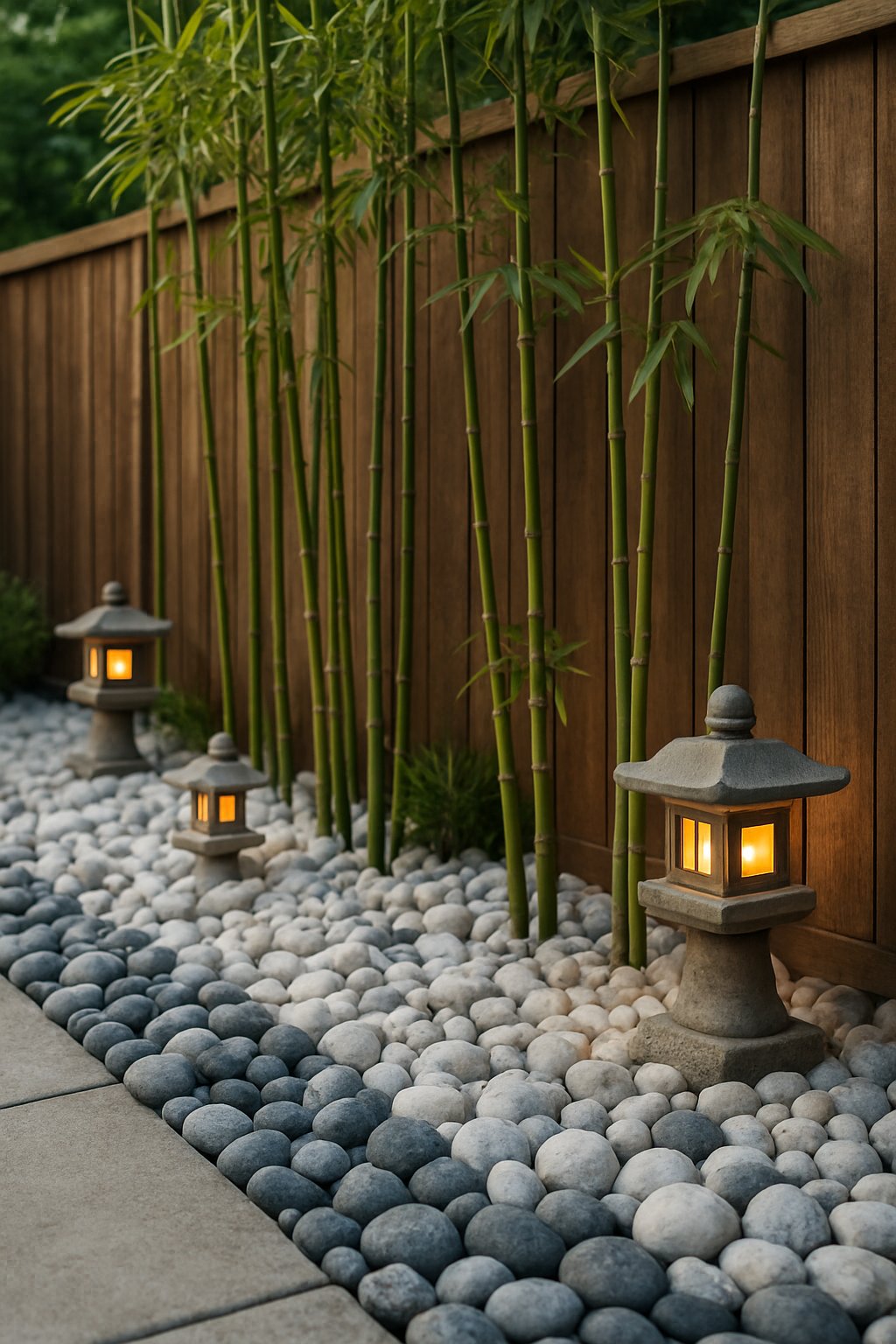
You might think a fence line is just for plants, but you can totally turn it into something special.
Imagine a skinny strip along your fence turning into a little zen garden.
Bamboo brings a calm, peaceful vibe with those tall, swaying stems.
Scatter some smooth pebbles and you’ll want to slow down and enjoy the moment.
Add a few mini lanterns and you’ve got gentle light for cozy evenings.
Just a handful of details and suddenly, your yard feels balanced and soothing.
You don’t need much space for a zen garden strip, so even small yards can join the fun.
It’s easy to keep up with—just rake the pebbles now and then, trim the bamboo, and you’re set.
Expert Tip From MrPlanter: Keep your bamboo healthy by watering regularly but avoid soggy soil. Small lanterns look best when spaced evenly—try soft LED candles for a safe glow.
How To Choose the Right Plants for Fence Line Landscaping
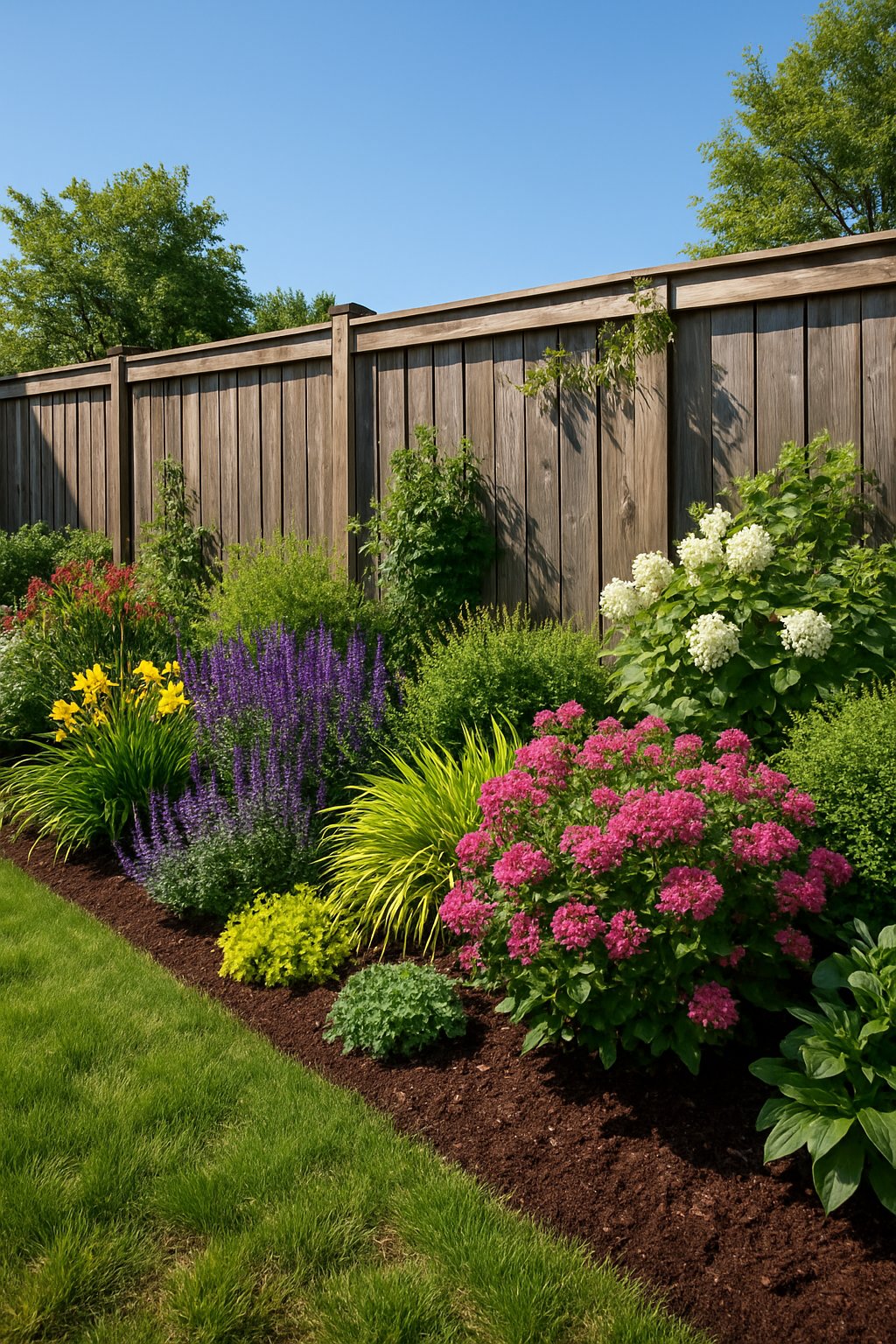
Picking plants for your fence line is honestly a bit like setting up friends on a blind date.
You want a good match for your yard’s mood, the right mix of privacy and style, and to avoid any awkward pairings.
Let’s talk about what really matters so your fence can finally steal the spotlight.
Understanding Your Yard’s Microclimate
Your fence’s little corner of the yard makes a huge difference.
Is it baking in the sun or hiding out in the shade?
Does the wind whip through, or is it tucked away and cozy?
These tiny details decide which plants will be happy and which ones will just sulk.
If your fence line gets full sun (6+ hours daily), go for sun-loving vines or shrubs that can handle the heat and still look good.
Got more shade? Plants like ferns or hostas will chill out there just fine.
And don’t forget about the dirt!
Is your soil dry and sandy, or does it stay wet after rain?
Pick plants that like what you’ve got, and you’ll spend way less time fussing.
Balancing Privacy and Aesthetics
Your fence line has two jobs: keep nosy neighbors out and look great while doing it.
If you want privacy, plant tall, thick shrubs or bamboo to block views and add texture all year.
Feeling creative? Mix in flowering climbers and short shrubs for layers and pops of color.
Think about how tall your plants get and how fast they grow.
Slow growers are chill but take patience, while fast growers fill in quickly but need more trimming.
I like to mix both for a little balance and surprise.
Common Mistakes to Avoid
Don’t treat your fence line like a clown car—cramming in too many plants just makes everyone miserable.
Give each plant room to stretch out based on how big it’ll get later.
Watch out for plant drama queens—some don’t play nice with others, so check who gets along before planting side by side.
And please, don’t put big trees right next to your fence.
Their roots can mess things up, and they’ll steal sunlight from the smaller plants.
If you’re busy (who isn’t?), pick low-maintenance plants that don’t need constant watering and haircuts.
Your future self will be grateful, trust me.
Fence Line Landscaping Maintenance Tips
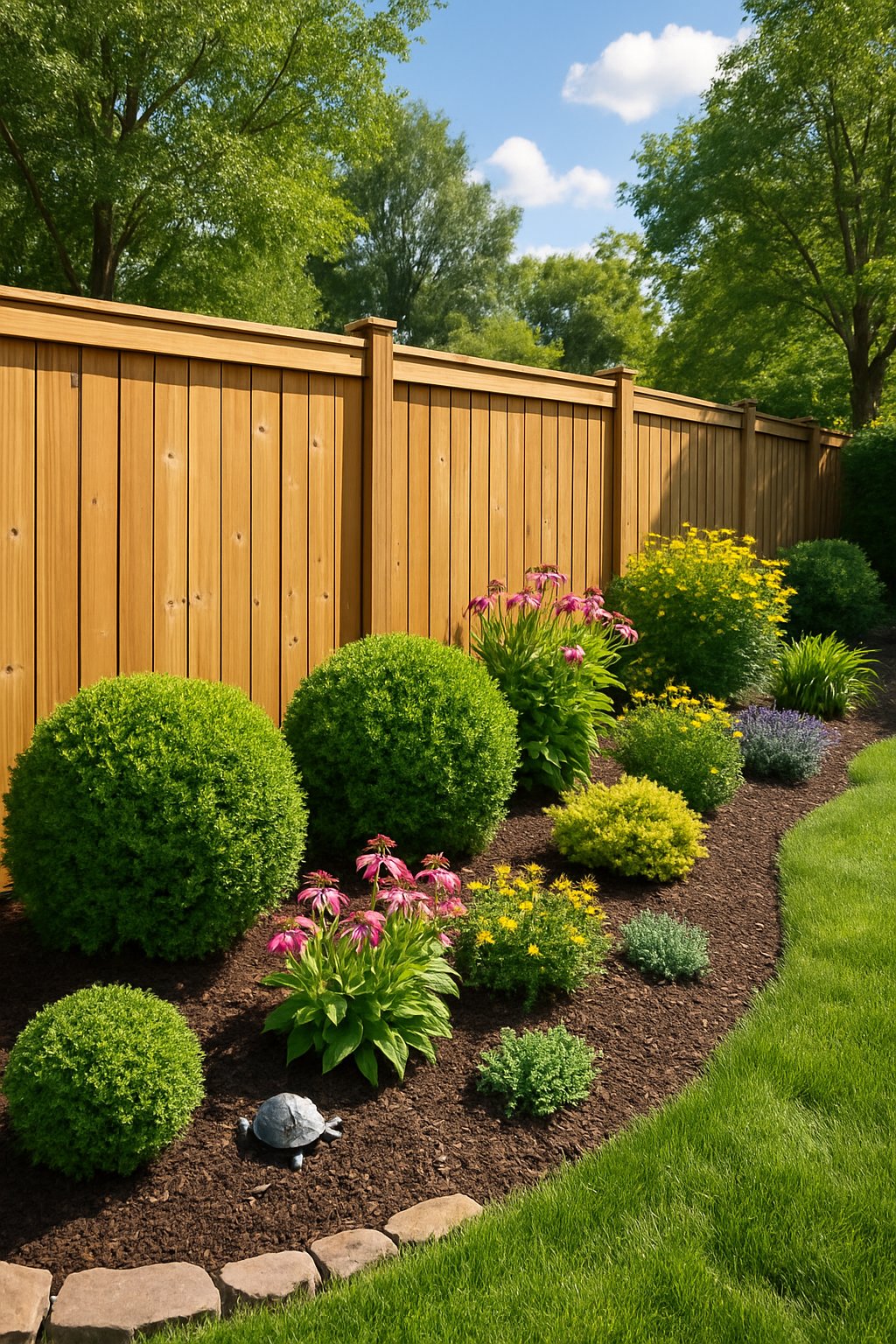
Keeping your fence line looking sharp isn’t rocket science, but it does need a little regular care.
You’ll want to trim plants, kick out weeds, and know when your landscaping needs a little extra attention.
Pruning Without the Drama
Pruning doesn’t have to be a big deal.
Trim your fence line plants a little at a time—think of it like a quick haircut instead of waiting until it’s a wild mess.
This keeps things tidy and lets the sun reach all your plants.
Use sharp, clean tools so you don’t hurt anything.
Snip off dead or yellow leaves first.
Don’t go overboard—a good rule is to cut back about a third of the plant.
If you’ve got flowering shrubs, prune them right after they finish blooming so you don’t chop off next year’s flowers.
Keeping Weeds at Bay
Weeds love to sneak into your fence line, but you can stop them.
Mulch is your secret weapon.
Spread a thick layer around your plants to block sunlight and keep soil moist.
Pull weeds as soon as you see them—they’re way easier to yank out when they’re small.
Grab gloves and a hand fork to get the roots, so they don’t pop back up.
Dense shrubs or groundcovers also help—if you fill the space, weeds won’t have any room to crash your garden party.
Seasonal Upkeep Strategies
Every season kinda throws its own curveballs at your fence line. In spring, I like to grab my gloves and clear out dead branches that somehow multiply every year.
I usually toss down some fresh mulch too. Honestly, that’s also when I get the itch to toss in new plants or seeds—because who can resist a little garden shopping?
Summer rolls in, and the soil dries out faster than you’d think. I water deep, but not too often, so those roots toughen up.
You’ll want to peek under leaves for pests or weird spots. If something looks off, I treat it early—trust me, ignoring it never works out.
When fall shows up, it’s time to prune back some plants and scoop up all those leaves. Leftover leaves can sneak in mold or bugs, and nobody wants that mess.
Winter is pretty chill—just tuck in your tender plants with covers or a cozy layer of mulch. That’s about it.
I keep a scrappy calendar or set reminders on my phone for these little jobs. It keeps my fence line looking sharp, and honestly, it makes the whole yard pop!

